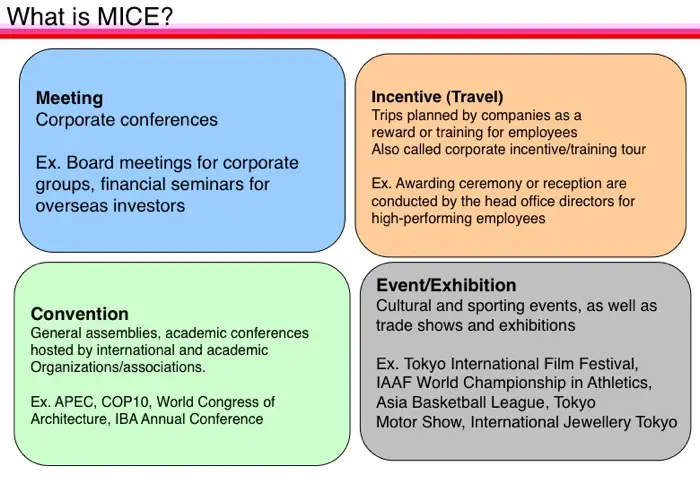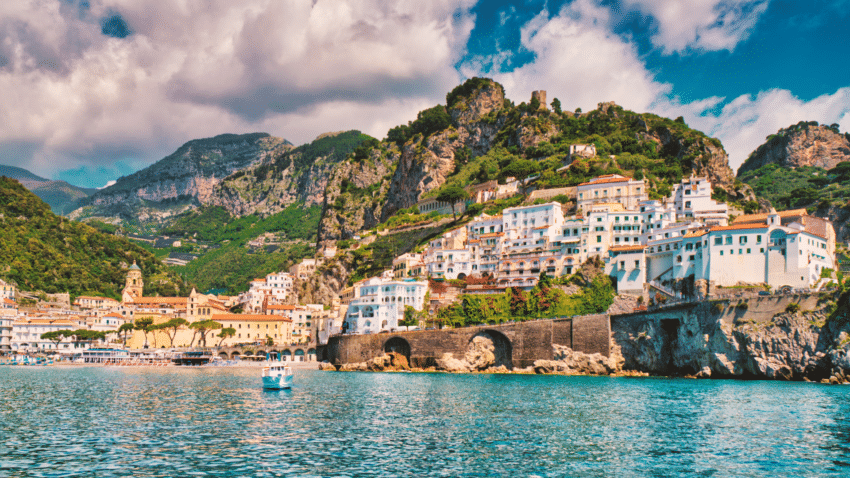

What is business tourism and why is it so big?
Disclaimer: Some posts on Tourism Teacher may contain affiliate links. If you appreciate this content, you can show your support by making a purchase through these links or by buying me a coffee . Thank you for your support!
In 2017, the world travel and tourism industry contributed more than $10 trillion dollars to the global economy. Of this amount, business tourism contributed a significant proportion, with a total of $1.23 trillion dollars.
Modern society transportation and infrastructure systems continue to revolutionise and therefore business tourism has the means to provide greater economic power than it has previously.
In this post, I will focus on the growing tourism industry of ‘business tourism’. I will explain what business tourism is, why business tourism is part of the tourism industry and provide a few examples of where business tourism takes place.
What is business tourism?
Definitions of business tourism, why is business tourism important, international exhibitors, corporate hospitality events, conferences, leisure time activities, benefits of business tourism, top business tourism destinations, business tourism in hong kong, business tourism in london, business tourism in new york, business tourism in toronto, business tourism in san francisco, business tourism: a conclusion, further reading.

Business tourism, or business travel, is essentially a form of travel which involves undertaking business activities that are based away from home.
The United Nations World Tourism Organization (UNWTO) defines tourists as people ‘traveling to and staying in places outside their usual environment for not more than one consecutive year for leisure, business and other purposes’, thus making business an important and integral sector of the tourism economy.
Business tourism activities includes attending meetings, congresses, exhibitions, incentive travel and corporate hospitality.
Academically, there isn’t a huge amount of literature on the characterisation of ‘business tourism’ or ‘business travel’. However, to quote from Davidson (1994) ‘Business tourism is concerned with people travelling for purposes which are related to their work.’
Business tourism represents one of the oldest forms of tourism, man having travelled for the purpose of travel since very early times” (cited in Bathia, 2006, p.272). To elaborate, business tourism is a means of travel that takes place for the primarily importance of a work-related activity.
Often the term ‘business tourism’ is described as ‘business traveller/travellers’.
There is a strong and correlative relation amongst a country’s economy and business tourism.
Business travellers are less cost sensitive on their expenditure as they themselves generally devote only a fraction of the cost. Research has shown that business travellers spend up to four times more during their trip than any other types of tourists . In fact, early research by Davidson and Cope , discovered that the ratio of daily expenditure by business travellers to that of leisure is generally situated somewhat between 2:1 and 3:1.
Therefore, business tourism provides significant economic contributions to the local and global economy. Business tourism also promotes the development for advanced infrastructure and transportation systems which also benefits other forms of tourism as well as the local population .
Business tourism also supports the hospitality industry, i.e. hotel bookings and restaurant bookings. This form of tourism also supports leisure tourism as business travellers tend to combine both activities together. This is referred as ‘bleisure tourism’, the combination of ‘business’ and ‘leisure’.
Business tourism activities

There are many forms of business tourism activities. Here I have demonstrated four key examples.
Business travellers may travel for the purpose of attending an exhibition. Exhibitions offer opportunities for businesses to connect with the international industry community. The exhibition industry entices two groups of people: those with something to sell and those who attend with a view to making a purchase of getting information.
Exhibitions come in all shapes and sizes depending on a person’s area of interest or work. As I have an interest in tourism I have attended a number of relevant travel exhibitions in recent years including ITB in Berlin and The World Travel Market in the UK.

Throughout many business excursions, the business traveller will have some form of meeting to attend during the course of their trip. Meetings may be appointments with clients; a board meeting at the present company or interstate of international branches; or an orientation meeting with staff at a new branch. Meetings can take place face-to-face or electronically using means such as Skype or FaceTime.
Corporate hospitality is a form of business travel that takes place when a corporation invites their guests to attend an event or an organised activity at no extra charge.
Corporate hospitality is a valuable tool used by corporations to foster relations, both internal and external to the company or to brand in influential circles. The extent to which corporate hospitality can yield tangible and intangible benefits is covered really well in the bestselling business book from award-winning restauranteur Danny Meyer, of Union Square Cafe, Gramercy Tavern, and Shake Shack entitled Setting the Table: The Transforming Power of Hospitality in Business .
A conference is a formal meeting of people with a shared interest. Conferences may last a day or they may last several days.
Conferences are common across a number of industries. Having worked in academia for a number of years, I have attended and presented at many conferences such as the ICOT conference in Thailand in 2017 and the International Conference on Sustainable Tourism in Nepal in 2018. I even won the three minute thesis competition at a PhD conference that I attended at the University of Staffordshire!
There are also many conferences and get togethers for travel bloggers that I am interested, such as TBEX , Traverse and Travel Massive .
Often in the business tourism literature you will come across the term MICE. MICE is a reference for Meetings, Incentives, Conferences and Events. The term MICE has been recognised as ‘The Meeting Industry’ according to the United Nations World Tourism Organisation .
The MICE industry contributes significantly to the wider business tourism sector. It is becoming increasingly recognised as a prominent part of the industry and is beginning to receive growing attention amongst the academic community. You can read a detailed article about MICE tourism here.

Along with the examples demonstrated above, business travellers also participate in leisure activities outside of their business commitments. These activities could range from dining out, sightseeing and other recreational activities. When I attended a conference in Nepal in 2017, for example, I took my mother in law and daughter along for the conference gala dinner where we took part in traditional Nepalese evening celebrations!

There are many benefits of business tourism. Notably, it brings economic value to the wider tourism industry as well as the local economy, for example through hotel bookings or sales of business travel backpacks . What many people forget to mention, however, are the benefits that business tourism can also have for the tourist!
I have travelled many times for business, whether this as part of my former Cabin Crew career, for an academic conference or to undertake consultancy work. Travelling frequently for work can yield many benefits for the individual, such as;
- Collecting frequent flier miles and redeeming these for personal use
- Becoming a member of hotel loyalty programmes and receiving associated benefits during both work and personal trips
- Saving money on things such as food and drink when attending corporate hospitality events
- Enhanced networking opportunities that may otherwise be inaccessible
- Taking advantage of leisure opportunities that may be otherwise inaccessible
- Enjoying the use of facilities, such as gyms or swimming pools, that may not otherwise be available to you
Business tourism destinations

There are a variety of business tourism destinations all across the world. However, this type of tourism is predominantly situated in global north countries. This is mainly because global north countries are developed countries and have the means to provide well equipped resources and infrastructure to makes business tourism easily accessible and thus desirable choices among business travellers.
According to Egencia , the corporate travel group collected data from flight booking and reservations during the years 2014 and 2018. Their collection of data led them to discover the top 20 destinations for global business tourism.
Following the list above, I have listed a set of examples of business tourism that are listed within the top ten destinations for global business tourism/travel.
Hong Kong ranks 8 th in the world for global business tourism and has been deemed one of Asia’s top choice for business travel. According to CTM , Central and Tsim Sha Tsui are the most popular commercial areas for business travel, with several hotels and business headquarters.
Hong Kong is the perfect destination for MICE (meetings, incentives, conferences and events) and in 2014, this form of tourism accounted for 1.82 million visitors.
There are around 283 hotels in Hong Kong.
There are a variety of things to do in Hong Kong during a business trip of the traveller is wanting to blend business and leisure together. A list of things to do are:
- Victoria Peak
- Tian Tan Buddha
- Victoria Harbour The Peak Tram
London ranks 2 nd in the world for global business tourism. London is the financial capital of the world and with this status comes several high-profile companies and is thought to be one of the best places to network and seek new business opportunities. This is why so many business tourists visit London for conferences, meetings and exhibitions.
London has around 1500 hotels.
There are a variety of things to do in London during a business trip of the traveller is wanting to blend business and leisure together. A list of things to do are:
- Buckingham Palace
- Coco Cola London Eye
- The British Museum
- Palace of Westminster
In 2019, New York was named the world’s top destination for business tourism for the fourth consecutive year. At no surprise when business travel flight bookings increased by more than 120% between 2014 and 2018.
New York is also a popular destination for business tourism as it offers a great deal of leisure activities and promotes the idea of blending business with leisure travel.
There are a variety of things to do in New York during a business trip of the traveller is wanting to blend business and leisure together. A list of things to do are:
- Statue of Liberty National Monument
- Central Park
- Empire State Building
- The Metropolitan Museum of Art
Toronto has been ranked the 5 th destination for global business tourism, outranking major commercial centres in the U.S.
Toronto (pronounced as “Traw-no” by the locals), is the financial capital of Canada. And according to Business Events, Toronto is the top Canadian domestic travel destination and the most popular choice for U.S sponsored association meetings outside the U.S.
In Toronto there are over 170 hotels which collectively has around 36,000 hotel rooms.
There are a variety of things to do in Toronto during a business trip of the traveller is wanting to blend business and leisure together. A list of things to do are:
- Royal Ontario Museum Art Gallery of Ontario
San Francisco has been ranked 7 th in the world for global business tourism. According to The San Francisco Travel Association , San Francisco welcomed 18.9 million leisure visitors and 5.8 million business travellers in 2015.
According to Joe D’Alessandro, president and CEO of San Francisco Travel, San Francisco is “experiencing sustained growth in all market segments – domestic, international, leisure and business – as a result of our highly professional and sophisticated community of hotels, restaurants, cultural organizations and SFO, one of the finest airports in the world.”
There are a variety of things to do in San Francisco during a business trip of the traveller is wanting to blend business and leisure together. A list of things to do are:
- Fisherman’s Wharf
- Golden Gate Bridge
- Golden Gate Park
Where business exists, the demand for business travel follows. Business tourism is predominantly located where good transportation systems are allocated, i.e. airports, taxis, railways. The choices of hotels and restaurants also attracts business travel.
Do you travel for business? What things do you look out for on your business trip? Are you a lover of combining business and leisure activities? Leave a comment below.
Like this post? For more on different types of tourism, I’d suggest reading my tourism glossary !
- Setting the Table: The Transforming Power of Hospitality in Business – The bestselling business book from award-winning restauranteur Danny Meyer, of Union Square Cafe, Gramercy Tavern, and Shake Shack
- Event Planning: The Ultimate Guide To Successful Meetings, Corporate Events, Fundraising Galas, Conferences, Conventions, Incentives and Other Special Events – An academic text focussing on MICE in the events industry
- The Business of Tourism – A introductory text to the tourism industry
- Travel, Tourism & Hospitality ›
Business Travel
Global business travel - statistics & facts
Business travel costs, covid-19 impact on business travel, key insights.
Detailed statistics
Global business travel spending 2001-2022
World's best-rated destination countries for non-leisure tourists 2021
Growth rate of global business travel spending 2001-2026
Editor’s Picks Current statistics on this topic
Global corporate travel market size 2020-2028
Meetings & Events
Global MICE industry size 2019-2030
Business Travel Spending
Countries with highest business travel spending 2023
Further recommended statistics
Business travel market.
- Premium Statistic Global corporate travel market size 2020-2028
- Basic Statistic Distribution of travel and tourism expenditure worldwide 2019-2023, by type
- Premium Statistic Global business travel spending 2001-2022
- Premium Statistic Growth rate of global business travel spending 2001-2026
- Premium Statistic Countries with highest business travel spending 2023
- Premium Statistic World's main travel agencies 2020, by sales share
- Premium Statistic Expectations of business travel providers about revenue at their companies 2022
- Premium Statistic Buyers' expectations about business travel volume at their companies 2022
Market value of the business travel industry worldwide in 2020, with a forecast for 2028 (in billion U.S. dollars)
Distribution of travel and tourism expenditure worldwide 2019-2023, by type
Distribution of travel and tourism spending worldwide in 2019 and 2023, by type
Expenditure of business tourists worldwide from 2001 to 2022 (in billion U.S. dollars)
Percentage change in expenditure of business tourists worldwide from 2001 to 2022, with forecast until 2026
Leading business tourism markets worldwide in 2023, based on total travel spending (in billion U.S. dollars)
World's main travel agencies 2020, by sales share
Leading travel companies worldwide in 2020, by share of global sales
Expectations of business travel providers about revenue at their companies 2022
Expected change in revenue from business tourism for travel management companies worldwide as of January 2022
Buyers' expectations about business travel volume at their companies 2022
Expected change in the volume of business travel services purchased by travel managers at companies worldwide as of January 2022
Association meetings and events
- Premium Statistic Number of international organization meetings worldwide 2015-2021
- Premium Statistic Share of international organization meetings worldwide 2001-2020, by region
- Premium Statistic Outlook on event spaces available in hotels worldwide 2022
- Premium Statistic Hoteliers' predicted business event spend worldwide 2022
- Premium Statistic Preferred corporate events' setup worldwide 2023, by region
Number of international organization meetings worldwide 2015-2021
Number of meetings held by international associations worldwide from 2015 to 2021 (in 1,000s)
Share of international organization meetings worldwide 2001-2020, by region
Distribution of international association meetings held worldwide between 2001 and 2020, by region
Outlook on event spaces available in hotels worldwide 2022
Expectations of hoteliers on the availability of meeting spaces worldwide in 2022
Hoteliers' predicted business event spend worldwide 2022
Expected change on business meeting spend according to hoteliers worldwide in 2022
Preferred corporate events' setup worldwide 2023, by region
Favorite formats of business meetings planned worldwide in 2023, by region
Exhibitions and trade shows
- Premium Statistic COVID-19 impact on exhibitions and trade shows worldwide 2020
- Premium Statistic Operation of the global exhibition industry 2022-2023
- Premium Statistic Main influencing aspects to exhibit at trade shows 2020-2021
- Premium Statistic Challenges of the global exhibition and trade show industry 2022
- Premium Statistic Comparison between digital and live exhibitions by visitors worldwide 2021
- Premium Statistic Largest exhibition halls worldwide 2023, by gross hall capacity
COVID-19 impact on exhibitions and trade shows worldwide 2020
Key figures on the economic impact of the coronavirus (COVID-19) pandemic on the exhibition industry worldwide in 2020
Operation of the global exhibition industry 2022-2023
Operation of exhibitions and trade shows worldwide in 2022 and predictions for 1st half 2023
Main influencing aspects to exhibit at trade shows 2020-2021
Leading factors influencing the decision of exhibitors to participate in events and trade shows worldwide in Q2 2020 and Q2 2021
Challenges of the global exhibition and trade show industry 2022
Most important issues facing the exhibition industry worldwide as of December 2022
Comparison between digital and live exhibitions by visitors worldwide 2021
Opinions on virtual versus in-person exhibitions and trade shows according to visitors worldwide as of 2021
Largest exhibition halls worldwide 2023, by gross hall capacity
Largest exhibition halls worldwide as of December 2023, by gross hall capacity (in 1,000 square meters)
Destinations
- Premium Statistic World's best-rated destination countries for non-leisure tourists 2021
- Premium Statistic Countries planning the largest number of business events and trade fairs 2023
- Premium Statistic Main country destinations for business meetings 2022
- Premium Statistic World's main cities for MICE tourism 2020
- Premium Statistic World's highest-priced business travel destinations Q4 2022
- Premium Statistic Highest hotel expenses in business travel destinations Q4 2022
- Premium Statistic Inbound business travel volume in selected countries worldwide 2019
World's best-rated destination countries for non-leisure tourists 2021
Leading countries for non-leisure travel worldwide in 2021, based on the Travel and Tourism Development Index
Countries planning the largest number of business events and trade fairs 2023
Leading host countries for conferences and trade shows planned worldwide as of August 2023, by number of events
Main country destinations for business meetings 2022
Leading countries for association meetings and events worldwide in 2022, by number of in-person events
World's main cities for MICE tourism 2020
Leading cities for association meetings worldwide in 2020, by number of regional events
World's highest-priced business travel destinations Q4 2022
Most expensive cities for business tourism worldwide in 4th quarter 2022, by average daily costs (in U.S. dollars)
Highest hotel expenses in business travel destinations Q4 2022
Most expensive cities for business tourism worldwide in 4th quarter 2022, by daily hotel cost (in U.S. dollars)
Inbound business travel volume in selected countries worldwide 2019
Number of international business tourist arrivals in selected countries worldwide in 2019 (in millions)
Business travel amid COVID-19
- Premium Statistic COVID-19: main barriers for international business tourism worldwide 2022
- Basic Statistic Impact of COVID-19 travel restrictions on business outcomes 2022
- Premium Statistic Change in business travel bookings for travel suppliers 2021-2022
- Premium Statistic Tourism professionals' outlook for global business travel 2022-2023
- Premium Statistic Employees' disposition towards business travel worldwide 2020-2023
- Premium Statistic Most stressful factors of flying for work purposes 2022, by travel phase
- Premium Statistic Change in interest in bleisure travel by global corporate travel managers 2023
COVID-19: main barriers for international business tourism worldwide 2022
Leading obstacles for international business travel amid coronavirus (COVID-19) pandemic according to companies worldwide as of January 2022
Impact of COVID-19 travel restrictions on business outcomes 2022
Perceived effect of government travel restrictions amid the coronavirus (COVID-19) pandemic on companies worldwide as of February 2022
Change in business travel bookings for travel suppliers 2021-2022
Change in travel bookings from corporate customers reported by travel suppliers worldwide from February 2021 to September 2022
Tourism professionals' outlook for global business travel 2022-2023
Opinion of travel suppliers and travel management companies on the path to recovery from COVID-19 of the business travel industry worldwide from January 2022 to January 2023
Employees' disposition towards business travel worldwide 2020-2023
Willingness of employees to take business trips according to travel managers worldwide from November 2020 to January 2023
Most stressful factors of flying for work purposes 2022, by travel phase
Main stress aspects of a business air trip according to travelers worldwide as of March 2022, by stage of the trip
Change in interest in bleisure travel by global corporate travel managers 2023
Increase in interest of employees in combining business trips with leisure activities according to business travel buyers worldwide as of October 2023
Further reports
Get the best reports to understand your industry.
Mon - Fri, 9am - 6pm (EST)
Mon - Fri, 9am - 5pm (SGT)
Mon - Fri, 10:00am - 6:00pm (JST)
Mon - Fri, 9:30am - 5pm (GMT)
Reimagining the $9 trillion tourism economy—what will it take?
Tourism made up 10 percent of global GDP in 2019 and was worth almost $9 trillion, 1 See “Economic impact reports,” World Travel & Tourism Council (WTTC), wttc.org. making the sector nearly three times larger than agriculture. However, the tourism value chain of suppliers and intermediaries has always been fragmented, with limited coordination among the small and medium-size enterprises (SMEs) that make up a large portion of the sector. Governments have generally played a limited role in the industry, with partial oversight and light-touch management.
COVID-19 has caused an unprecedented crisis for the tourism industry. International tourist arrivals are projected to plunge by 60 to 80 percent in 2020, and tourism spending is not likely to return to precrisis levels until 2024. This puts as many as 120 million jobs at risk. 2 “International tourist numbers could fall 60-80% in 2020, UNWTO reports,” World Tourism Organization, May 7, 2020, unwto.org.
Reopening tourism-related businesses and managing their recovery in a way that is safe, attractive for tourists, and economically viable will require coordination at a level not seen before. The public sector may be best placed to oversee this process in the context of the fragmented SME ecosystem, large state-owned enterprises controlling entry points, and the increasing impact of health-related agencies. As borders start reopening and interest in leisure rebounds in some regions , governments could take the opportunity to rethink their role within tourism, thereby potentially both assisting in the sector’s recovery and strengthening it in the long term.
In this article, we suggest four ways in which governments can reimagine their role in the tourism sector in the context of COVID-19.
1. Streamlining public–private interfaces through a tourism nerve center
Before COVID-19, most tourism ministries and authorities focused on destination marketing, industry promotions, and research. Many are now dealing with a raft of new regulations, stimulus programs, and protocols. They are also dealing with uncertainty around demand forecasting, and the decisions they make around which assets—such as airports—to reopen will have a major impact on the safety of tourists and sector employees.
Coordination between the public and private sectors in tourism was already complex prior to COVID-19. In the United Kingdom, for example, tourism falls within the remit of two departments—the Department for Business, Energy, and Industrial Strategy (BEIS) and the Department for Digital, Culture, Media & Sport (DCMS)—which interact with other government agencies and the private sector at several points. Complex coordination structures often make clarity and consistency difficult. These issues are exacerbated by the degree of coordination that will be required by the tourism sector in the aftermath of the crisis, both across government agencies (for example, between the ministries responsible for transport, tourism, and health), and between the government and private-sector players (such as for implementing protocols, syncing financial aid, and reopening assets).
Concentrating crucial leadership into a central nerve center is a crisis management response many organizations have deployed in similar situations. Tourism nerve centers, which bring together public, private, and semi-private players into project teams to address five themes, could provide an active collaboration framework that is particularly suited to the diverse stakeholders within the tourism sector (Exhibit 1).
We analyzed stimulus packages across 24 economies, 3 Australia, Bahrain, Belgium, Canada, Egypt, Finland, France, Germany, Hong Kong, Indonesia, Israel, Italy, Kenya, Malaysia, New Zealand, Peru, Philippines, Singapore, South Africa, South Korea, Spain, Switzerland, Thailand, and the United Kingdom. which totaled nearly $100 billion in funds dedicated directly to the tourism sector, and close to $300 billion including cross-sector packages with a heavy tourism footprint. This stimulus was generally provided by multiple entities and government departments, and few countries had a single integrated view on beneficiaries and losers. We conducted surveys on how effective the public-sector response has been and found that two-thirds of tourism players were either unaware of the measures taken by government or felt they did not have sufficient impact. Given uncertainty about the timing and speed of the tourism recovery, obtaining quick feedback and redeploying funds will be critical to ensuring that stimulus packages have maximum impact.
2. Experimenting with new financing mechanisms
Most of the $100 billion stimulus that we analyzed was structured as grants, debt relief, and aid to SMEs and airlines. New Zealand has offered an NZ $15,000 (US $10,000) grant per SME to cover wages, for example, while Singapore has instituted an 8 percent cash grant on the gross monthly wages of local employees. Japan has waived the debt of small companies where income dropped more than 20 percent. In Germany, companies can use state-sponsored work-sharing schemes for up to six months, and the government provides an income replacement rate of 60 percent.
Our forecasts indicate that it will take four to seven years for tourism demand to return to 2019 levels, which means that overcapacity will be the new normal in the medium term. This prolonged period of low demand means that the way tourism is financed needs to change. The aforementioned types of policies are expensive and will be difficult for governments to sustain over multiple years. They also might not go far enough. A recent Organisation for Economic Co-operation and Development (OECD) survey of SMEs in the tourism sector suggested more than half would not survive the next few months, and the failure of businesses on anything like this scale would put the recovery far behind even the most conservative forecasts. 4 See Tourism policy responses to the coronavirus (COVID-19), OECD, June 2020, oecd.org. Governments and the private sector should be investigating new, innovative financing measures.
Revenue-pooling structures for hotels
One option would be the creation of revenue-pooling structures, which could help asset owners and operators, especially SMEs, to manage variable costs and losses moving forward. Hotels competing for the same segment in the same district, such as a beach strip, could have an incentive to pool revenues and losses while operating at reduced capacity. Instead of having all hotels operating at 20 to 40 percent occupancy, a subset of hotels could operate at a higher occupancy rate and share the revenue with the remainder. This would allow hotels to optimize variable costs and reduce the need for government stimulus. Non-operating hotels could channel stimulus funds into refurbishments or other investment, which would boost the destination’s attractiveness. Governments will need to be the intermediary between businesses through auditing or escrow accounts in this model.
Joint equity funds for small and medium-size enterprises
Government-backed equity funds could also be used to deploy private capital to help ensure that tourism-related SMEs survive the crisis (Exhibit 2). This principle underpins the European Commission’s temporary framework for recapitalization of state-aided enterprises, which provided an estimated €1.9 trillion in aid to the EU economy between March and May 2020. 5 See “State aid: Commission expands temporary framework to recapitalisation and subordinated debt measures to further support the economy in the context of the coronavirus outbreak,” European Commission, May 8, 2020, ec.europa.eu. Applying such a mechanism to SMEs would require creating an appropriate equity-holding structure, or securitizing equity stakes in multiple SMEs at once, reducing the overall risk profile for the investor. In addition, developing a standardized valuation methodology would avoid lengthy due diligence processes on each asset. Governments that do not have the resources to co-invest could limit their role to setting up those structures and opening them to potential private investors.
3. Ensuring transparent, consistent communication on protocols
The return of tourism demand requires that travelers and tourism-sector employees feel—and are—safe. Although international organizations such as the International Air Transport Association (IATA), and the World Travel & Tourism Council (WTTC) have developed a set of guidelines to serve as a baseline, local regulators are layering additional measures on top. This leads to low levels of harmonization regarding regulations imposed by local governments.
Our surveys of traveler confidence in the United States suggests anxiety remains high, and authorities and destination managers must work to ensure travelers know about, and feel reassured by, protocols put in place for their protection. Our latest survey of traveler sentiment in China suggests a significant gap between how confident travelers would like to feel and how confident they actually feel; actual confidence in safety is much lower than the expected level asked a month before.
One reason for this low level of confidence is confusion over the safety measures that are currently in place. Communication is therefore key to bolstering demand. Experience in Europe indicates that prompt, transparent, consistent communications from public agencies have had a similar impact on traveler demand as CEO announcements have on stock prices. Clear, credible announcements regarding the removal of travel restrictions have already led to increased air-travel searches and bookings. In the week that governments announced the removal of travel bans to a number of European summer destinations, for example, outbound air travel web search volumes recently exceeded precrisis levels by more than 20 percent in some countries.
The case of Greece helps illustrate the importance of clear and consistent communication. Greece was one of the first EU countries to announce the date of, and conditions and protocols for, border reopening. Since that announcement, Greece’s disease incidence has remained steady and there have been no changes to the announced protocols. The result: our joint research with trivago shows that Greece is now among the top five summer destinations for German travelers for the first time. In July and August, Greece will reach inbound airline ticketing levels that are approximately 50 percent of that achieved in the same period last year. This exceeds the rate in most other European summer destinations, including Croatia (35 percent), Portugal (around 30 percent), and Spain (around 40 percent). 6 Based on IATA Air Travel Pulse by McKinsey. In contrast, some destinations that have had inconsistent communications around the time frame of reopening have shown net cancellations of flights for June and July. Even for the high seasons toward the end of the year, inbound air travel ticketing barely reaches 30 percent of 2019 volumes.
Digital solutions can be an effective tool to bridge communication and to create consistency on protocols between governments and the private sector. In China, the health QR code system, which reflects past travel history and contact with infected people, is being widely used during the reopening stage. Travelers have to show their green, government-issued QR code before entering airports, hotels, and attractions. The code is also required for preflight check-in and, at certain destination airports, after landing.
4. Enabling a digital and analytics transformation within the tourism sector
Data sources and forecasts have shifted, and proliferated, in the crisis. Last year’s demand prediction models are no longer relevant, leaving many destinations struggling to understand how demand will evolve, and therefore how to manage supply. Uncertainty over the speed and shape of the recovery means that segmentation and marketing budgets, historically reassessed every few years, now need to be updated every few months. The tourism sector needs to undergo an analytics transformation to enable the coordination of marketing budgets, sector promotions, and calendars of events, and to ensure that products are marketed to the right population segment at the right time.
Governments have an opportunity to reimagine their roles in providing data infrastructure and capabilities to the tourism sector, and to investigate new and innovative operating models. This was already underway in some destinations before COVID-19. Singapore, for example, made heavy investments in its data and analytics stack over the past decade through the Singapore Tourism Analytics Network (STAN), which provided tourism players with visitor arrival statistics, passenger profiling, spending data, revenue data, and extensive customer-experience surveys. During the COVID-19 pandemic, real-time data on leading travel indicators and “nowcasts” (forecasts for the coming weeks and months) could be invaluable to inform the decisions of both public-sector and private-sector entities.
This analytics transformation will also help to address the digital gap that was evident in tourism even before the crisis. Digital services are vital for travelers: in 2019, more than 40 percent of US travelers used mobile devices to book their trips. 7 Global Digital Traveler Research 2019, Travelport, marketing.cloud.travelport.com; “Mobile travel trends 2019 in the words of industry experts,” blog entry by David MacHale, December 11, 2018, blog.digital.travelport.com. In Europe and the United States, as many as 60 percent of travel bookings are digital, and online travel agents can have a market share as high as 50 percent, particularly for smaller independent hotels. 8 Sean O’Neill, “Coronavirus upheaval prompts independent hotels to look at management company startups,” Skift, May 11, 2020, skift.com. COVID-19 is likely to accelerate the shift to digital as travelers look for flexibility and booking lead times shorten: more than 90 percent of recent trips in China were booked within seven days of the trip itself. Many tourism businesses have struggled to keep pace with changing consumer preferences around digital. In particular, many tourism SMEs have not been fully able to integrate new digital capabilities in the way that larger businesses have, with barriers including language issues, and low levels of digital fluency. The commission rates on existing platforms, which range from 10 percent for larger hotel brands to 25 percent for independent hotels, also make it difficult for SMEs to compete in the digital space.
Governments are well-positioned to overcome the digital gap within the sector and to level the playing field for SMEs. The Tourism Exchange Australia (TXA) platform, which was created by the Australian government, is an example of enabling at scale. It acts as a matchmaker, connecting suppliers with distributors and intermediaries to create packages attractive to a specific segment of tourists, then uses tourist engagement to provide further analytical insights to travel intermediaries (Exhibit 3). This mechanism allows online travel agents to diversify their offerings by providing more experiences away from the beaten track, which both adds to Australia’s destination attractiveness, and gives small suppliers better access to customers.

Governments that seize the opportunity to reimagine tourism operations and oversight will be well positioned to steer their national tourism industries safely into—and set them up to thrive within—the next normal.
Download the article in Arabic (513KB)
Margaux Constantin is an associate partner in McKinsey’s Dubai office, Steve Saxon is a partner in the Shanghai office, and Jackey Yu is an associate partner in the Hong Kong office.
The authors wish to thank Hugo Espirito Santo, Urs Binggeli, Jonathan Steinbach, Yassir Zouaoui, Rebecca Stone, and Ninan Chacko for their contributions to this article.
Explore a career with us
Related articles.

Make it better, not just safer: The opportunity to reinvent travel

Hospitality and COVID-19: How long until ‘no vacancy’ for US hotels?
A new approach in tracking travel demand
What next for travel and tourism? Here's what the experts say

In many countries, more than 80% of travel and tourism spending actually comes from the domestic market. Image: Unsplash/Surface
.chakra .wef-1c7l3mo{-webkit-transition:all 0.15s ease-out;transition:all 0.15s ease-out;cursor:pointer;-webkit-text-decoration:none;text-decoration:none;outline:none;color:inherit;}.chakra .wef-1c7l3mo:hover,.chakra .wef-1c7l3mo[data-hover]{-webkit-text-decoration:underline;text-decoration:underline;}.chakra .wef-1c7l3mo:focus,.chakra .wef-1c7l3mo[data-focus]{box-shadow:0 0 0 3px rgba(168,203,251,0.5);} Julie Masiga

.chakra .wef-9dduvl{margin-top:16px;margin-bottom:16px;line-height:1.388;font-size:1.25rem;}@media screen and (min-width:56.5rem){.chakra .wef-9dduvl{font-size:1.125rem;}} Explore and monitor how .chakra .wef-15eoq1r{margin-top:16px;margin-bottom:16px;line-height:1.388;font-size:1.25rem;color:#F7DB5E;}@media screen and (min-width:56.5rem){.chakra .wef-15eoq1r{font-size:1.125rem;}} Mobility is affecting economies, industries and global issues

.chakra .wef-1nk5u5d{margin-top:16px;margin-bottom:16px;line-height:1.388;color:#2846F8;font-size:1.25rem;}@media screen and (min-width:56.5rem){.chakra .wef-1nk5u5d{font-size:1.125rem;}} Get involved with our crowdsourced digital platform to deliver impact at scale
Stay up to date:.
- In 2020 alone, the travel and tourism sector lost $4.5 trillion and 62 million jobs globally.
- But as the world recovers from the impacts of the COVID-19 pandemic, travel and tourism can bounce back as an inclusive, sustainable, and resilient sector.
- Two experts highlight some of the key transformations in the sector going forward during the World Economic Forum's Our World in Transformation series.
The Travel & Tourism sector was one of the hardest hit by the COVID-19 pandemic, leaving not only companies but also tourism-driven economies severely affected by shutdowns, travel restrictions and the disappearance of international travel.
In 2020 alone, the sector lost $4.5 trillion and 62 million jobs, impacting the living standards and well-being of communities across the globe. Moreover, the halt in international travel gave both leisure and business travellers the chance to consider the impact of their choices on the climate and environment.
Amid shifting demand dynamics and future opportunities and risks, a more inclusive, sustainable and resilient travel and tourism sector can be - and needs to be - built.
The World Economic Forum's Travel & Tourism Development Index 2021 finds that embedding inclusivity, sustainability and resilience into the travel and tourism sector as it recovers, will ensure it can continue to be a driver of global connectivity, peace and economic and social progress.
We spoke to Sandra Carvao , Chief of Market Intelligence and Competitiveness at the United Nations World Tourism Organization (UNWTO), and Liz Ortiguera , CEO of the Pacific Asia Travel Association in Thailand (PATA), and asked them to highlight some of the key areas of risk and opportunity in the sector during an episode of the World Economic Forum's Our World in Transformation series.
Have you read?
Travel & tourism development index 2021: rebuilding for a sustainable and resilient future, towards resilience and sustainability: travel and tourism development recovery, how can we really achieve sustainability in the travel sector, what are some of the top global trends you're witnessing currently in the travel and tourism sector.
Liz Ortiguera: Given the extended lockdown that we had on travel with the pandemic, vacation for friends and relatives (VFR) is now a high priority for people who haven’t been in touch for a long time thanks to the pandemic. So, people are reconnecting. And that kind of links to the second trend, which is multi-purpose or blended travel. Never before, particularly now that we can connect digitally through Zoom, has the ability to work from anywhere enabled travellers to cover multiple purposes, like visits with friends and multiple business trips. So, we'll find that the duration of travel and the length of stay is longer. And third is the continued high focus on safety and wellness which is top of mind for travellers due to the pandemic. All travel is wellness-related now.
Sandra Carvao: I think there is a bigger concern with sustainability, which is very welcome in our industry. Consumers, particularly the younger generation, are much more aware of the impact they have, not only on the environment but also socially and on the communities they live in. We've also seen an increase in expenditure per trip, so I think people are very eager to go outside, and they're staying longer. And on the other side, I think there are some challenges: we’re seeing a rise in late bookings because restrictions can change at short notice and that’s having an impact on the decisions of travellers. This is putting pressure on the industry in terms of planning and anticipating fluctuations in demand.
Social media surveys have shown that travellers who have immersive experiences are more likely to post about them, which is good for the industry.
What is community-based tourism and why is it important?
Sandra Carvao: One of the positive impacts of the pandemic is that people are looking for local experiences and are spending more time with communities. So, the concept of community-based tourism is obviously one that puts the community at the core of every development, ensuring that it's engaged and empowered and that it benefits. At the UNWTO, we worked with the G20 and the Saudi presidency back in 2020 and produced a framework for tourism development in communities, which states that communities need to be part of the planning and management of tourism activities. We need to go beyond traditional definitions of community to a point where the industry leans on partnerships between the public and private sectors and communities.
Liz Ortiguera: In July 2022, PATA is hosting a destination-marketing forum and one of the key themes is community-based tourism. The purpose is really to put the community and authenticity-in-culture activities at the heart of the travel experience. There are benefits for all stakeholders. One is that travellers can have an authentic experience. They're not in overcrowded, touristic locations and they experience something new and unique within the community. These experiences are designed in partnership with communities who get the benefit of financial inclusion, and if activities are designed properly, the reinforcement of their cultural heritage. Governments also engage in economic development more broadly across countries. Another interesting trend is creative tourism, which means you create an experience for tourists to participate in, like a dance lesson, or a cooking lesson. Social media surveys have shown that travellers who have these kinds of immersive experiences are more likely to post about them online and that's good for the industry.
It is important to emphasize that virtual experiences, while they are a fun tool, can never replace visiting a destination.
How is technology and innovation helping to leverage cultural resources?
Sandra Carvao: One interesting trend we’re seeing is that more and more people are booking trips directly, so communities need to be supported to digitize their systems. Education and upskilling of communities are important so that they can leverage digital platforms to market themselves. From the tourists’ perspective, it is important to emphasize that virtual experiences, while they are a fun tool, can never replace visiting a destination.
Liz Ortiguera: People have been living virtually for more than two years. Amazing innovations have emerged, such as virtual reality and augmented reality, and all kinds of applications and tools. But the important thing is the experience. The destination. Real-world experiences need to remain front and centre. Technology tools should be viewed as enablers and not the core experience. And when it comes to staff, technology can really democratize education. There’s an opportunity to mobilize a mobile-first approach for those who are on the frontlines, or out in the field, and can’t easily access computers, but need to get real-time information.

How is the sector dealing with labour shortages and re-employment of the workforce?
Liz Ortiguera: Labour shortages are much more dynamic in North America and in Europe. But it’s having a knock-on effect on Asia. If, for example, their air carriers are limited by staff and they have to cancel flights, which we're very much seeing out of Europe, seating capacity then becomes a limiting factor in the recovery of Asia Pacific. That's the main constraint right now. And compounding that is the rising price of fuel. But people in the Asia Pacific are keen to get reemployed.
Sandra Carvao: Labour shortages are a priority for the sector in countries around the world. Many workers left the sector during the pandemic and the uncertainty that surrounded the measures taken to contain it left many people unsure of whether the sector would recover. It is time to address things like conditions, scheduling, and work/life balance, all things which have been top of mind for workers during the pandemic. As the sector recovers, we need time to bring new hires on board and to train them to take over where those who switched jobs left off.
Are we seeing a growing trend towards domestic tourism?
Sandra Carvao: We’re talking about 9 billion people travelling within their own countries. And in many countries, for example in Germany, more than 80% of the tourism spending actually comes from the domestic market, similarly in countries like Spain and even smaller economies. Whenever it's possible to travel again, domestic markets tend to be more resilient. They kick off first mostly due to perceptions of safety and security issues. As the world economy recovers from the pandemic, there is a good opportunity for nations to rethink their strategy, look at the domestic market in a different way, and leverage different products for domestic tourists.

When it comes to sustainable tourism, how quickly could we mainstream eco-friendly modes of transportation?
Sandra Carvao: Transport is one of the key contributors to energy impacts and tourism. But it's also important that we look at the whole value chain. The UNWTO together with the One Planet Sustainable Tourism Programme just launched the Glasgow Declaration, which includes green commitments from destinations and companies. We’re seeing a strong movement in the airline industry to reduce emissions. But I think, obviously, technological developments will be very important. But it's also very important to look at market shifts. And we can't forget small islands and developing states that rely on long-haul air travel. It’s important to make sure that we invest in making the problem much less impactful.
Liz Ortiguera: 'Travel and tourism' is such a broad encompassing term that it’s not fair to call it an industry: it is actually a sector of many industries. The pandemic taught us how broad the impact of the sector is in terms of sustainability. There's a big movement in terms of destination resilience, which is the foundation for achieving sustainability in the journey to net-zero. We now have standards to mitigate that impact including meetings-and-events (MIE) standards and standards for tour operators. There are multiple areas within our industry where progress is being made. And I'm really encouraged by the fact that there is such a focus not just within the sector but also among consumers.
This interview was first done at the World Economic Forum's studios in Geneva as part of 'Our World in Transformation' - a live interactive event series for our digital members. To watch all the episodes and join future sessions, please subscribe here .
Don't miss any update on this topic
Create a free account and access your personalized content collection with our latest publications and analyses.
License and Republishing
World Economic Forum articles may be republished in accordance with the Creative Commons Attribution-NonCommercial-NoDerivatives 4.0 International Public License, and in accordance with our Terms of Use.
The views expressed in this article are those of the author alone and not the World Economic Forum.
Related topics:
The agenda .chakra .wef-n7bacu{margin-top:16px;margin-bottom:16px;line-height:1.388;font-weight:400;} weekly.
A weekly update of the most important issues driving the global agenda
.chakra .wef-1dtnjt5{display:-webkit-box;display:-webkit-flex;display:-ms-flexbox;display:flex;-webkit-align-items:center;-webkit-box-align:center;-ms-flex-align:center;align-items:center;-webkit-flex-wrap:wrap;-ms-flex-wrap:wrap;flex-wrap:wrap;} More on Industries in Depth .chakra .wef-17xejub{-webkit-flex:1;-ms-flex:1;flex:1;justify-self:stretch;-webkit-align-self:stretch;-ms-flex-item-align:stretch;align-self:stretch;} .chakra .wef-nr1rr4{display:-webkit-inline-box;display:-webkit-inline-flex;display:-ms-inline-flexbox;display:inline-flex;white-space:normal;vertical-align:middle;text-transform:uppercase;font-size:0.75rem;border-radius:0.25rem;font-weight:700;-webkit-align-items:center;-webkit-box-align:center;-ms-flex-align:center;align-items:center;line-height:1.2;-webkit-letter-spacing:1.25px;-moz-letter-spacing:1.25px;-ms-letter-spacing:1.25px;letter-spacing:1.25px;background:none;padding:0px;color:#B3B3B3;-webkit-box-decoration-break:clone;box-decoration-break:clone;-webkit-box-decoration-break:clone;}@media screen and (min-width:37.5rem){.chakra .wef-nr1rr4{font-size:0.875rem;}}@media screen and (min-width:56.5rem){.chakra .wef-nr1rr4{font-size:1rem;}} See all

The energy transition could shift the global power centre. This expert explains why
Liam Coleman
June 4, 2024

Top 5 countries leading the sustainable tourism sector

Robot rock stars, pocket forests, and the battle for chips - Forum podcasts you should hear this month
Robin Pomeroy and Linda Lacina
April 29, 2024

Agritech: Shaping Agriculture in Emerging Economies, Today and Tomorrow

Confused about AI? Here are the podcasts you need on artificial intelligence
Robin Pomeroy
April 25, 2024

Which technologies will enable a cleaner steel industry?
Daniel Boero Vargas and Mandy Chan

An official website of the United States government
Here’s how you know
Official websites use .gov A .gov website belongs to an official government organization in the United States.
Secure .gov websites use HTTPS A lock ( Lock A locked padlock ) or https:// means you’ve safely connected to the .gov website. Share sensitive information only on official, secure websites.

U.S. Department of Commerce
- Fact Sheets
Was this page helpful?
Fact sheet: 2022 national travel and tourism strategy, office of public affairs.
The 2022 National Travel and Tourism Strategy was released on June 6, 2022, by U.S. Secretary of Commerce Gina M. Raimondo on behalf of the Tourism Policy Council (TPC). The new strategy focuses the full efforts of the federal government to promote the United States as a premier destination grounded in the breadth and diversity of our communities, and to foster a sector that drives economic growth, creates good jobs, and bolsters conservation and sustainability. Drawing on engagement and capabilities from across the federal government, the strategy aims to support broad-based economic growth in travel and tourism across the United States, its territories, and the District of Columbia.
The federal government will work to implement the strategy under the leadership of the TPC and in partnership with the private sector, aiming toward an ambitious five-year goal of increasing American jobs by attracting and welcoming 90 million international visitors, who we estimate will spend $279 billion, annually by 2027.
The new National Travel and Tourism Strategy supports growth and competitiveness for an industry that, prior to the COVID-19 pandemic, generated $1.9 trillion in economic output and supported 9.5 million American jobs. Also, in 2019, nearly 80 million international travelers visited the United States and contributed nearly $240 billion to the U.S. economy, making the United States the global leader in revenue from international travel and tourism. As the top services export for the United States that year, travel and tourism generated a $53.4 billion trade surplus and supported 1 million jobs in the United States.
The strategy follows a four-point approach:
- Promoting the United States as a Travel Destination Goal : Leverage existing programs and assets to promote the United States to international visitors and broaden marketing efforts to encourage visitation to underserved communities.
- Facilitating Travel to and Within the United States Goal : Reduce barriers to trade in travel services and make it safer and more efficient for visitors to enter and travel within the United States.
- Ensuring Diverse, Inclusive, and Accessible Tourism Experiences Goal : Extend the benefits of travel and tourism by supporting the development of diverse tourism products, focusing on under-served communities and populations. Address the financial and workplace needs of travel and tourism businesses, supporting destination communities as they grow their tourism economies. Deliver world-class experiences and customer service at federal lands and waters that showcase the nation’s assets while protecting them for future generations.
- Fostering Resilient and Sustainable Travel and Tourism Goal : Reduce travel and tourism’s contributions to climate change and build a travel and tourism sector that is resilient to natural disasters, public health threats, and the impacts of climate change. Build a sustainable sector that integrates protecting natural resources, supporting the tourism economy, and ensuring equitable development.
Travel and Tourism Fast Facts
- The travel and tourism industry supported 9.5 million American jobs through $1.9 trillion of economic activity in 2019. In fact, 1 in every 20 jobs in the United States was either directly or indirectly supported by travel and tourism. These jobs can be found in industries like lodging, food services, arts, entertainment, recreation, transportation, and education.
- Travel and tourism was the top services export for the United States in 2019, generating a $53.4 billion trade surplus.
- The travel and tourism industry was one of the U.S. business sectors hardest hit by the COVID-19 pandemic and subsequent health and travel restrictions, with travel exports decreasing nearly 65% from 2019 to 2020.
- The decline in travel and tourism contributed heavily to unemployment; leisure and hospitality lost 8.2 million jobs between February and April 2020 alone, accounting for 37% of the decline in overall nonfarm employment during that time.
- By 2021, the rollout of vaccines and lifting of international and domestic restrictions allowed travel and tourism to begin its recovery. International arrivals to the United States grew to 22.1 million in 2021, up from 19.2 million in 2020. Spending by international visitors also grew, reaching $81.0 billion, or 34 percent of 2019’s total.
More about the Tourism Policy Council and the 2022 National Travel and Tourism Strategy
Created by Congress and chaired by Secretary Raimondo, the Tourism Policy Council (TPC) is the interagency council charged with coordinating national policies and programs relating to travel and tourism. At the direction of Secretary Raimondo, the TPC created a new five-year strategy to focus U.S. government efforts in support of the travel and tourism sector which has been deeply and disproportionately affected by the COVID-19 pandemic.
Read the full strategy here
We earn commissions if you shop through the links below. Read more
21 Tourism and Travel Business Ideas
Back to Business Ideas Categories
Written by: Carolyn Young
Carolyn Young is a business writer who focuses on entrepreneurial concepts and the business formation. She has over 25 years of experience in business roles, and has authored several entrepreneurship textbooks.
Edited by: David Lepeska
David has been writing and learning about business, finance and globalization for a quarter-century, starting with a small New York consulting firm in the 1990s.
Published on July 21, 2022 Updated on May 3, 2024

The tourism industry is massive and diverse, offering many opportunities for sharp entrepreneurs. You could start a travel agency, a campground, a hotel, or a concierge service. Explore many more excellent tourism and travel related business ideas in our list below.
1. Travel Agency

If you love to travel and are always planning your next trip, starting a travel agency might be the perfect career choice. It’s a great way to share your love and knowledge of travel, and it can be very lucrative.
If you have the resources, starting a travel agency business can be a breeze. But first, you need to identify your target market. Will you focus on domestic or international travel? A lot of Americans go on short trips for vacation or business purposes, providing an opportunity for travel agencies to earn money. Once you find your niche and draw up a business plan, you should work on establishing your brand and promoting it to find clients.
2. Nightclub

Do you enjoy late nights on the town? If so, starting a club might be right up your alley. Before you open your club, it’s important to know that the industry is heavily regulated, especially when it comes to alcohol consumption. You’ll need to meet both state and local regulations and licensing requirements so it’s best to inquire about the details from your local authorities first.
Next, it’s a good idea to research the market and find out what other clubs in your area are offering. You’ll have to innovate and come up with a unique selling proposition and a creative marketing plan for your club to attract customers. With these in place, your club can be very profitable.
3. Travel Photography

Are you an amateur photographer who loves snapping great images? Photography in the US is an $11 billion industry expected to see steady growth in the coming years, so now would be a great time to stretch your entrepreneurial wings and give it a shot. You could focus on travel photography, if that’s your passion, and give the world beautiful photos while also seeing the world. You can capture landscapes, people, cultures, customs, and history.
Assuming you already have a professional-level camera, you’ll just need some great editing software and to build a website showing off your portfolio and listing your prices and services. Instagram and Pinterest are perfect social media networks for showing your travel photography.

If you’ve stayed in an Airbnb, you probably know how sweet it is to have a home away from home! This is why the homestay segment of the hotel and lodgings market has seen explosive growth in recent years, with Airbnb leading the way. Renting out your home as an Airbnb is an easy and flexible way to earn income, whether you’re looking for a little extra money or to build a serious business.
The first step is to make sure your home or apartment can be rented out for short-term stays. In many areas today, there are laws either banning Airbnb rentals or limiting them to a certain share of local units. If your home clears that hurdle and is in an area with some tourist appeal, you’re already halfway there. If your apartment fails to meet one of these requirements, you might want to look into purchasing a home or apartment in an appealing destination, which you could then develop into a successful Airbnb.
Whichever approach you choose, the most important step is delivering fantastic service to your guests. If you can achieve Superhost status, you’ll be well on your way to Airbnb success.
5. Translation Business

Demand for translation services is expected to grow as more companies seek to capture or increase their share of the global market. Translation businesses help translate documents, localize travel and city guide websites, and interpret speech, including sign language. If you’re thinking of starting a translation business, you’re not alone. But if you have the skills and the right talents and tools, you could edge out the competition.
In this internet age, finding translators who can work remotely across the globe has become easier. Promoting diversity among your staff could also be good for your business because you’ll be able to offer translation services for more languages. Do the paperwork to register your business, keep yourself updated with the latest technologies, promote your services, and you should be able to gain traction as soon as you start operating.
6. Bed and Breakfast

Many Americans still prefer to stay in a traditional B&B for the unique hospitality, homemade food, and fascinating local insights. When starting a B&B, it’s important to be aware of the latest industry trends. For example, many guests prefer a facility that offers live entertainment or is located close to tourist attractions. It’s also to your advantage to research the market and see what features and services are being offered by the competition. Be innovative in coming up with ways to differentiate your business. Running a bed and breakfast is not easy, but it can be very rewarding if you play your cards right.
7. Glamping

A decade ago nobody had heard the word glamping, which is short for “glamorous camping”. Today it’s a nearly $3.1 billion global industry and among the fastest-growing segments of the travel and hospitality market, expected to more than double by 2030. If you have a bit of land in an appealing location, or have the funds to purchase such a plot, you could start your own glamping business and make a good living offering luxury experiences to discerning travelers.
There will be some serious work involved. In addition to acquiring the property, you’ll need to outfit it with all the bells and whistles — from tents and teepees to high-end beds, furniture, lighting and air-conditioning and heating units. If your location is on the water, you could boost your revenue by also offering sailboats, canoes, kayaks, and more. But before you get started, this is a new and fast-evolving industry, so it’s best to take the time to research the market and learn the latest trends before diving in.
8. Jet Ski Rental

Do you like having fun out on the water? Well, so does everybody else! That’s why starting a jet ski business is almost always a great idea. The global personal watercraft market is worth $1.6 trillion and expected to expand an impressive 50% by 2027. Right now is a great time to start a jet ski business, bring good times to your community and ride the market expansion to great success.
Getting there will require a significant investment. You’ll need to spend about $25,000 to get your first few jet skis, plus a rental facility on the water and permits and licensing fees. Of course, you’ll also need to live near an appealing body of water, preferably one that’s enjoyable for more than a few months of the year. Finally, you will want to get good insurance, because jet skis are as dangerous as they are fun.
Once that’s all settled, just start advertising on local outlets and events, posting on relevant social media groups and online vacation platforms. You’ll have your first few customers in no time, and soon be cruising toward success.
9. Campground

Do you love the outdoors? If so, setting up a campground could be the perfect way to start your entrepreneurial journey. The recent study found that an estimated 84.8 million Americans went camping in 2023, and 5.5 million of those were first-time campers.
Your biggest challenge in starting a campground is likely to be finding a suitable location. The most visited campgrounds in the US are in state parks, near bodies of water, surrounded by wilderness, or in the mountains. Once you find an ideal campsite, you’ll need to comply with licensing, zoning, and other legal requirements. Before you launch your business, it’s wise to research the market and find out what other campgrounds are offering. With careful planning and a creative marketing strategy, your campground can give competing sites a run for their money.
10. Pet Sitting

You’d probably never guess that pet sitting is a $2.4 billion industry , but it is indeed. People love their pets, and will spend whatever it takes to ensure they’re taken care of when they are away. The pet sitting market is projected to see impressive growth through 2030, so if you’re an animal lover, now is the perfect time to start your own pet sitting business and ride that wave to serious profits.
The first step is to decide which type of pets you’ll care for. Do you have more experience with dogs or cats? Are you OK with snakes? Pigs? Once you’ve got that nailed down, you’ll just need to buy some pet toys and supplies and offer your services on a gigs site like TaskRabbit. It’s a good idea to reach out to friends, family and work-related contacts and acquaintances. If you’re able to generate an initial client or two from your own personal network, and provide them with great service, you’ll have a strong reference to promote your services and start building a successful business.
11. Spa Salon

If you’re a massage therapist or esthetician, you could open a beauty salon, nail spa, luxury spa, massage studio, or even a mobile spa, and make people feel better while making a good living.
You will likely need to get licensed, which can take some doing, and deliver excellent services to compete in an increasingly competitive and saturated market. Another crucial aspect will be location — your spa should be somewhere with steady traffic. Or you could go the mobile spa route and make house calls, bringing your massage and therapeutic services to your clients. This is more convenient for them, which means you can charge a higher rate, despite having lower overhead.
There are many elements to consider for your spa business, but what is not in doubt are your chances of success if you’re determined and can deliver healing services.
12. Scooter Rental

With gas prices going up, more and more Americans are turning to cheaper, more eco-friendly options for their commute and for seeing the city. Scooters cost less than cars and run on electricity. Over the past decade, Americans took a third of a billion trips on shared bikes and scooters. That’s a huge number, and it’s expected to increase sharply in the next few years. Considering this, a scooter rental business is a smart choice.
But first, it’s important to understand that scooters are used primarily as a transport option for short distances. Setting up this kind of business requires a huge upfront investment because you might have to purchase some scooters, unless you can lease them. You’ve need to make sure you have all the necessary permits and insurance in place before opening.
Once you have everything you need, it’s a good idea to work on a marketing plan. You can use social media, print ads, and word-of-mouth to get the word out about your new venture.
13. Party Bus

Ready to party? As the pandemic recedes, everybody’s getting back out there to have a good time. For a lot of people that means renting out a party bus and dancing and drinking the night away while cruising down the streets.
Starting your own party bus business will require considerable investment. The major cost will be, of course, the bus itself. Hopefully you’ll be able to find a reliable one at a reasonable price and then deck it out with all the trimmings, from a bar and disco ball to a DJ booth and more. Once you’ve done some marketing and gotten the word out you’ll be able to charge as much as $700 per night, so it shouldn’t take too long before you see a major return on your investment.
Just be sure to get all your licenses, permits and insurance — the last thing you want is for the party to get parked on the curb.
14. Car Rental

With some hard work and determination, you could start your own car rental business and provide travelers the transport they need while grabbing your share of a growing $30 billion US market .
Keep in mind that this is a competitive industry, which means you’ll need to find ways to stand out, such as with deep discounts or a unique selection of cars. Speaking of which, you’ll also need to lay out a sizable investment to get your initial fleet of four to five cars. Finally, it’s crucial that you meet all the licensing and insurance requirements or your business could face severe fines, or worse.
But if you’re able to clear these hurdles, there’s a good chance your car rental business will soon be cruising down easy street.
15. Boat Rental

Who doesn’t love a day out on the water? There are so many things to do. from skiing and tubing to cruising, socializing, swimming and just taking in the sun. That’s why boat rentals are a $5.3 billion US industry expected to see smooth sailing and steady growth in the years ahead. If you like spending time outdoors, you could start your own boat rental business and help people enjoy their time off while making a good living.
There are several possible constraints. For one, you should live near a sizable body of water, and find an available access point or marina to base your operations. Second, you’ll likely need to accept the seasonal nature of this line of work, which in most areas of the US will only bring in revenue for 6-7 months of the year. Finally, getting started will require a significant investment, as appealing, rentable boats do not come cheap.
But if you’re OK with all this, and able to acquire the necessary permits and insurance, once you start putting boaters on the water you’ll be cruising straight toward success.
16. Bike Rental

As travel regains steam and more workers return to the office, demand for bike rental for last-mile connections is sure to increase. If you’re thinking of starting your own business, a bike-share outfit or bike rental shop could be a great option. The US bike rental industry is projected to grow in the next five years amid a bike-share boom, driven in part by environmental concerns.
There are a few things you need to consider before starting a bike rental business. Is there a market for bike rental in your area? What kind of bikes should you offer? How many bikes should you start with? You will find the answers to these questions as you research the market. It is also important to comply with all the legal and regulatory requirements and to come up with a good marketing plan. One option is to place bike docks near subway stations and major bus stops.
17. RV Rental

RVing , or traveling in a recreational vehicle, is a popular way of exploring the US with family and friends. It’s showing no signs of slowing as more than 70 million Americans are expected to go on road trips in an RV they rent, own, or borrow, according to the RV Industry Association. You could start an RV rental business and tap into this exciting travel market.
You can either invest in a fleet of RVs, which would require a hefty investment, or you can just list your RV on an online marketplace like Outdoorsy. Before setting your rates, it’s a good idea to scope out the market and find out what your competitors are charging. You’ll have to factor in insurance and other costs in order to make a profit.
Finally, it’s important to keep your RVs well-maintained to attract customers, most of whom prefer to rent out new units. With all this in place, your RV rental business will making good money in no time.
18. Kayak Rental

As more people explore the outdoors in a post-pandemic world, a kayak business makes sense. It’s an eco-friendly way to help travelers enjoy their time off while getting some exercise and enjoying the great outdoors. The global kayak accessories market size was $164.2 million in 2020 and will touch $214 million by 2027. So, why not start a kayak rental business now?
Aside from offering kayaks for rent, you could also also offer apparel and helmets, storage bags, seats, life jackets, and safety gear. Selecting the location of your shop is important. It will have to be near the coast, a river or a lake, and with steady foot traffic. You’ll need a substantial investment to set up your shop. Finally, it’s a good idea to promote your business and let people know about your offerings.

Considering all the ride-sharing apps out there, you might be surprised to learn that old-school taxis are not only surviving, but doing quite well. The US taxi and limo market is worth more than $41.7 billion and expected to see steady growth in the coming years. If you enjoy driving and meeting new people, starting a taxi business might be the right move for you.
Getting started will require some real effort and investment. You’ll need to buy a reliable car, if you don’t already have one, plus reliable insurance and all the necessary permits. In some cities the car hire license can be a major expense, for instance a New York City taxi medallion costs $80,000. In other places, like $300 in Cleveland, not so much. Once you’ve all set up, it’s a good idea to build a website so people can find you, and you might want to offer an app as well, as most car services nowadays offer on-demand ordering.
Finally, get creative with your marketing to stand out in a competitive market, provide excellent service and steady driving to your first few clients, and the good reviews and revenues should start pouring in.
20. RV Park

The wanderlust spirit and a rise in road-tripping have amplified the allure of RV travel. Capitalizing on this trend, starting an RV park presents a golden opportunity in the travel business sector. Such parks cater to a growing demographic of explorers seeking the comfort of their RVs while embracing the freedom of the open road. With the right amenities and a strategic location, an RV park can be a haven for both short-term travelers and long-term nomads.
Location is paramount, ideally near popular tourist spots or natural attractions. Additionally, ensuring modern facilities, security, and possibly offering unique experiences or events can differentiate your park from competitors. As travel patterns evolve, an RV park can offer travelers a blend of adventure and convenience, making it a profitable and sustainable business venture.
21. Tour Operator

Tour operator business thrives on curating unique experiences, offering tailored packages, and ensuring travelers get the best out of their journeys. Unlike general travel agencies, tour operators control and manage the specifics of the trip, right from itinerary planning to the on-ground execution. This means creating partnerships with local businesses, ensuring safety standards, and offering a seamless travel experience to clients.
In today’s digital age, a tour operator’s success doesn’t just hinge on local networking, but also on a strong online presence. Reviews, testimonials, and digital marketing strategies play a pivotal role in attracting potential customers. Whether one chooses to cater to adventure seekers, history enthusiasts, or luxury travelers, the key is to differentiate, maintain high service standards, and keep evolving with the dynamic travel industry.
Leave a Reply Cancel reply
Your email address will not be published. Required fields are marked *
Save my name, email, and website in this browser for the next time I comment.
- Travel Agency
- Travel Photography
- Translation Business
- Bed and Breakfast
- Jet Ski Rental
- Pet Sitting
- Scooter Rental
- Boat Rental
- Bike Rental
- Kayak Rental
- Tour Operator
Subscribe to Our Newsletter
Featured resources.

12 Profitable Lake Business Ideas
Esther Strauss
Published on December 1, 2022
Fresh air, peace of mind, scenic views, and lots of fun — that’s lake life in a nutshell, which is why so many people want to take part. ...

37 Summer Business Ideas
Carolyn Young
Published on July 21, 2022
Summer means taking a break, enjoying outdoor leisure, going to a summer camp, and BBQ’ing in the backyard. For smart entrepreneurs, it alsome ...

21 Profitable Beach Business Ideas
David Lepeska
So you live near a beach. Lucky you! You can go swimming or walk barefoot in the sand any time you like. Even better, you could also start abusiness ...
No thanks, I don't want to stay up to date on industry trends and news.
Understanding the Travel and Tourism Sector: A Business Perspective

The world of business is inextricably linked with the realm of travel and tourism. From corporate travel arrangements to the operation of hospitality giants, this sector plays a pivotal role in the global economy.
The travel and tourism industry is not merely about vacations and leisure; it encompasses a diverse array of activities, services, and businesses that fuel economies, create jobs, and shape the way we explore the world.
In this article, we will embark on a journey to understand the intricacies of the travel and tourism sector from a business standpoint. We will explore its significance in the global economy, delve into the core components of the industry, examine the economic impact, and discuss emerging trends and challenges.
Moreover, we will shed light on the business aspects of travel, highlighting the key players, revenue streams, and marketing strategies that drive success.
But why should business professionals, beyond those directly involved in tourism, care about this sector? The answer lies in the fact that travel and tourism intersect with nearly every industry. Whether you're in finance, technology, healthcare, or any other field, understanding how this sector operates can unlock opportunities for growth, collaboration, and innovation.
So, fasten your seatbelts and prepare for a journey through the multifaceted world of travel and tourism, where business meets exploration and economic growth meets wanderlust.
Travel and Tourism
Travel and tourism refer to the activities, services, and industries associated with people traveling to and staying in places outside their usual place of residence for leisure, business, or other purposes.
The Core Components of Travel and Tourism
At its heart, the travel and tourism sector comprises several key components, each playing a unique role in the industry's ecosystem. Understanding these components is crucial for any business professional aiming to navigate this dynamic sector effectively.
Here are the primary elements:
1. Accommodation: Accommodation providers are the backbone of the tourism industry. They include hotels, resorts, vacation rentals, and even unconventional options like Airbnb. These establishments cater to travelers by offering a place to stay, ranging from budget to luxury.
2. Transportation: Travel relies heavily on transportation. This segment encompasses airlines, cruise lines, railways, car rental services, and public transportation systems. Efficient transportation networks are vital for connecting travelers to their destinations.
3. Food and Beverage: Dining experiences are an integral part of any trip. This category includes restaurants, cafes, food trucks, and bars. Culinary tourism, where travelers explore local cuisine, has become a significant trend within this segment.
4. Travel Agencies: Travel agencies and tour operators serve as intermediaries between travelers and service providers. They help plan itineraries, book accommodations, and arrange transportation, making the travel process more convenient.
5. Attractions and Entertainment: Tourist destinations offer various attractions, from historical sites and museums to theme parks and natural wonders. Entertainment options such as theaters and music venues also contribute to the overall travel experience.
6. Travel Technology: In the digital age, technology has transformed the way people plan and experience travel. Online booking platforms, travel apps, and services like TripAdvisor have reshaped the industry's landscape.
7. Tourism Services: This category includes a range of services such as travel insurance, currency exchange, and visa assistance. These services ensure that travelers are prepared for their journeys and can navigate any unforeseen challenges.
8. Destination Management: Local governments and organizations play a pivotal role in managing and promoting tourist destinations. They invest in infrastructure, marketing, and sustainability efforts to attract visitors.
The Economic Impact of Travel and Tourism
From a business perspective, it's essential to grasp the significant economic impact of the travel and tourism sector. This industry is a global economic powerhouse that generates jobs, fosters investment and drives economic growth.
Here are some key statistics to illustrate the significance of travel and tourism :
- Job Creation: Travel and tourism directly support over 330 million jobs worldwide, accounting for 1 in 10 jobs globally.
- Contribution to GDP: In 2022, the travel and tourism sector contributed 7.6% to global GDP, highlighting its substantial economic footprint.
- Investment Magnet: This sector attracts investments in infrastructure, hotels, transportation, and more, further stimulating economic activity.
- Foreign Exchange Earnings: Tourism often serves as a vital source of foreign exchange earnings for many countries, boosting their balance of payments.
- SME Growth: Small and medium-sized enterprises (SMEs) play a significant role in the sector, benefiting from the opportunities created by tourism-related businesses.
The economic interplay between tourism and other industries is intricate.
For instance, the hospitality sector relies on agriculture for food supplies, airlines depend on the aerospace industry for aircraft and tourist destinations often collaborate with local artisans and businesses to promote cultural experiences.
In the business world, recognizing the economic clout of travel and tourism can open doors for collaboration, investment, and innovation. Many companies, even those seemingly unrelated to tourism, can find ways to tap into this lucrative market.
Emerging Trends and Challenges
The travel and tourism sector is continuously evolving, driven by changing consumer preferences, technological advancements, and global events. Business professionals must stay attuned to these trends and challenges to adapt and thrive in this dynamic industry.
Here are some notable developments:
1. Sustainable Tourism: Travelers increasingly prioritize eco-friendly and sustainable practices. Businesses that adopt green initiatives not only reduce their environmental footprint but also attract environmentally conscious travelers.
2. Digital Transformation: The digitalization of travel services has reshaped how consumers plan and book trips. Online platforms, artificial intelligence, and data analytics are instrumental in personalizing travel experiences.
3. Health and Safety: Recent global health crises have heightened travelers' concerns about safety and hygiene. Businesses must implement robust health and safety measures to regain consumer trust.
4. Shifts in Travel Behavior: The pandemic has brought about changes in travel behavior, with a focus on remote and nature-based destinations. Companies need to adapt their offerings to cater to these evolving preferences.
5. Regulatory Challenges: Navigating complex regulations, including visa requirements and health protocols, can be a challenge for travel businesses. Staying informed and compliant is crucial.
6. Geopolitical Factors: Political instability and international relations can significantly impact the tourism industry. Businesses must be prepared to adapt to changing geopolitical landscapes.
The Business of Travel and Tourism
Understanding how businesses operate within this sector is essential for both industry insiders and entrepreneurs looking to tap into this thriving market.
Role of Businesses in the Travel Sector
Businesses play a pivotal role in shaping the travel and tourism landscape. Whether you're a hotel chain, an airline, a tour operator, or a travel agency, your role is multifaceted, encompassing everything from customer service to marketing and sustainability initiatives.
- Customer-Centric Approach : At the heart of every successful travel and tourism business is a deep commitment to customer satisfaction. Travelers today expect exceptional service and unique experiences. From the moment a traveler starts planning their trip to the time they return home, businesses must focus on providing top-notch services, personalized recommendations, and seamless experiences.
- Innovation and Adaptation : The travel industry is highly competitive and constantly evolving. Successful businesses in this sector are those that innovate and adapt to changing trends. This could mean embracing digital technology, offering eco-friendly options, or creating new and exciting travel packages.
Business Models and Revenue Streams
To thrive in the travel and tourism sector, businesses employ various revenue models tailored to their specific niches. Here are a few common business models:
- Hospitality and Accommodation : Hotels, resorts, and vacation rentals rely on room bookings and additional services such as dining, spa treatments, and event hosting to generate revenue.
- Airlines and Transportation : Airlines make money through ticket sales, baggage fees, in-flight services, and partnerships with other travel-related businesses. Transportation services like taxis, trains, and cruise lines have similar revenue structures.
- Tour Operators and Travel Agencies : These businesses profit from organizing and selling travel packages, tours, and experiences. Commissions, booking fees, and tour sales are primary income sources.
- Online Travel Agencies (OTAs) : OTAs like Expedia and Booking.com aggregate information from various travel service providers and earn commissions on bookings made through their platforms.
Customer Experience and Service Excellence
In the digital age, the travel and tourism sector is driven by customer reviews and recommendations. Travelers share their experiences online, influencing the choices of others. Therefore, providing exceptional customer service is paramount. Here are some strategies to achieve service excellence:
- Personalization : Tailor recommendations and services to individual preferences.
- Seamless Booking and Travel : Make the booking process simple and provide support throughout the journey.
- Feedback and Improvement : Collect customer feedback and use it to enhance services continually.
- Crisis Management : Be prepared to handle unexpected situations, such as flight cancellations or health emergencies, with professionalism and empathy.
Marketing and Promotion Strategies
Effective marketing is essential for attracting travelers to your business. Here are some strategies commonly used in the travel and tourism industry:
- Digital Marketing : Utilize online channels such as social media, search engine optimization (SEO), email marketing, and paid advertising to reach a global audience.
- Content Marketing : Create engaging content, including blog posts, videos, and travel guides, to inspire and inform potential travelers.
- Partnerships : Collaborate with influencers, other businesses, and tourism boards to expand your reach and access new markets.
- Sustainability Promotion : Highlight your commitment to sustainable and responsible travel practices, as eco-conscious travelers seek eco-friendly options.
The business of travel and tourism is a multifaceted realm that demands a relentless focus on customer satisfaction, innovation, and responsible practices.
Success in this sector requires a deep understanding of your niche, a commitment to service excellence, and strategic marketing efforts. As the travel industry continues to evolve, businesses that can adapt and offer unique, memorable experiences will undoubtedly thrive in this exciting and ever-changing market.
Key Players in the Travel and Tourism Industry
As we dive deeper into the business of travel and tourism, it's crucial to recognize the key players that shape this industry. These players, ranging from airlines to accommodation providers and travel agencies, contribute to the diverse ecosystem of travel and tourism.
Understanding their roles and significance is essential for anyone interested in this dynamic sector.
Airlines and Aviation
Airlines are the lifelines of global travel. They provide the means for travelers to reach their destinations quickly and efficiently. Here's an overview of their role in the industry:
- Passenger Transportation : Airlines transport millions of passengers daily, connecting cities and countries across the globe. They generate revenue through ticket sales, baggage fees, and in-flight services.
- Cargo Services : Airlines also play a pivotal role in transporting goods and cargo, contributing significantly to international trade and logistics.
- Global Networks : Major airlines operate extensive global networks, allowing travelers to reach virtually any corner of the world.
Hotel Chains and Accommodation Providers
The hospitality sector, including hotels, resorts, and vacation rentals, is another cornerstone of the travel and tourism industry. Here's how they contribute:
- Lodging : These businesses offer lodging options, from budget-friendly to luxury, catering to diverse traveler preferences.
- Dining and Services : Many hotels provide dining options, spa services, event hosting, and recreational facilities, enhancing the guest experience and generating additional revenue.
- Destination Attraction : Iconic hotels and resorts often become attractions in themselves, drawing travelers to specific destinations.
Tour Operators and Travel Agencies
Tour operators and travel agencies specialize in creating and selling travel packages and experiences. Their roles include:
- Curating Experiences : They design itineraries and packages that offer unique and immersive travel experiences, from adventure tours to cultural excursions.
- Booking and Logistics : These businesses handle the logistics of travel, including accommodations, transportation, and activities, streamlining the process for travelers.
- Expertise : Tour operators and travel agencies provide expert guidance, helping travelers navigate complex travel decisions.
Destination Management Companies
Destination management companies (DMCs) focus on specific regions or destinations. Their roles encompass:
- Local Expertise : DMCs have in-depth knowledge of their respective destinations, enabling them to offer specialized services and experiences.
- Customized Services : They work closely with travel planners and agencies to tailor experiences for groups and individuals.
- Sustainability : DMCs often play a vital role in promoting responsible tourism practices within their destinations.
Online Travel Agencies (OTAs)
Online travel agencies have become a dominant force in the industry, leveraging digital platforms to connect travelers with various travel services. Here's what they do:
- Aggregation : OTAs aggregate information from airlines, hotels, and other travel service providers, offering a wide array of choices to travelers.
- Booking Platforms : They provide convenient booking platforms, allowing travelers to book flights, accommodations, and more in one place.
- Reviews and Recommendations : OTAs often feature user reviews and recommendations, influencing traveler decisions.
Understanding the roles of these key players in the travel and tourism industry is essential for anyone considering entering this sector.
Each player contributes uniquely to the travel experience, from transportation to accommodation and beyond. Successful businesses often collaborate with multiple stakeholders to offer comprehensive and memorable travel experiences to their customers.
Travel and Tourism Post-COVID-19
The travel and tourism industry, like many others, faced unprecedented challenges during the COVID-19 pandemic. Lockdowns, travel restrictions, and health concerns brought international travel to a standstill. However, the industry has displayed remarkable resilience and adaptability.
Let's explore how the sector is recovering and adapting in a post-pandemic world.
Impact of the Pandemic on the Industry
- Travel Restrictions : Stringent travel restrictions, including border closures and quarantine requirements, severely impacted international travel. Airlines faced a sharp decline in passenger numbers.
- Hospitality Struggles : Hotels and accommodation providers experienced a dramatic drop in occupancy rates. Many temporarily closed or adapted to offer quarantine and isolation services.
- Cruise Industry Challenges : Cruise lines faced significant setbacks due to onboard outbreaks. The industry had to reimagine health and safety protocols.
- Shift to Domestic Travel : With international travel restrictions, many travelers turned to domestic and regional destinations, boosting local tourism.
- Digital Transformation : The pandemic accelerated the adoption of digital technologies for contactless bookings, health monitoring, and communication.
Recovery and Adaptation Strategies
The travel and tourism industry is rebounding, thanks to a combination of factors:
- Vaccination Campaigns : Widespread vaccination campaigns have increased traveler confidence, making international travel safer.
- Health and Safety Protocols : Airlines, hotels, and other businesses have implemented robust health and safety measures to reassure travelers.
- Flexible Booking Policies : Many travel companies introduced flexible booking and cancellation policies to accommodate changing travel plans.
- Sustainability Focus : There's a growing emphasis on sustainable and responsible tourism, with businesses integrating eco-friendly practices.
- Digitalization : The industry continues to embrace digital technologies, offering contactless experiences and personalized services.
- Collaboration : Stakeholders across the industry are collaborating to rebuild and promote destinations.
Future Outlook and Resilience
The travel and tourism industry is poised for recovery and growth in the coming years. Here's what the future may hold:
- Pent-Up Demand : Many travelers postponed their plans during the pandemic, leading to pent-up demand for leisure and business travel.
- Sustainable Travel : Sustainable and eco-conscious travel is gaining momentum. Travelers are increasingly choosing destinations and businesses committed to environmental responsibility.
- Tech Integration : Technology will continue to play a significant role, with advancements in AI, mobile apps, and data analytics enhancing the travel experience.
- Health and Safety : Health and safety measures will remain a priority, with businesses maintaining rigorous protocols.
- Remote Work and Travel : Remote work trends may encourage a blend of work and leisure travel, with more extended stays in diverse locations.
- Resilience Planning : The industry is developing resilience plans to better handle future crises and disruptions.
The travel and tourism industry's ability to adapt and innovate in the face of adversity demonstrates its resilience. As it recovers and evolves, it offers promising opportunities for businesses and travelers alike.
The key to success lies in embracing change, prioritizing safety, and delivering exceptional experiences that meet the evolving needs of travelers in a changing world.
Sustainable Tourism and Responsible Business Practices
In a world increasingly concerned about the environment and social responsibility, the travel and tourism industry is under scrutiny to adopt more sustainable and responsible practices.
Let's delve into the importance of sustainable tourism and how businesses can contribute to a greener and more ethical travel sector.
Environmental and Social Responsibility
- Reducing Carbon Footprint : The travel industry is a significant contributor to greenhouse gas emissions. Airlines, for example, are exploring biofuels and more fuel-efficient aircraft to reduce their carbon footprint.
- Preserving Natural Resources : Eco-conscious travelers seek destinations that protect and preserve natural resources. Businesses can contribute by implementing eco-friendly initiatives like energy-efficient facilities and waste reduction programs.
- Conservation Efforts : Supporting local conservation projects and wildlife protection initiatives can be a part of responsible tourism. This can involve financial contributions or active participation.
- Respecting Local Cultures : Responsible tourism respects and celebrates local cultures and traditions. It involves engaging with local communities in a respectful and sustainable manner.
- Community Involvement : Businesses can support the communities they operate in through job creation, fair wages, and community development projects.
Sustainable Tourism Certifications and Initiatives
- Eco-Certifications : Numerous certifications, such as EarthCheck and Green Key , help businesses showcase their commitment to sustainability. These certifications often involve rigorous audits of a company's environmental practices.
- Zero-Waste Initiatives : Some hotels and resorts aim to become zero-waste establishments, recycling and repurposing nearly all their waste.
- Wildlife Conservation : Tour operators and businesses can partner with wildlife conservation organizations to promote ethical wildlife experiences.
- Local Sourcing : Restaurants and hotels can prioritize local sourcing of food and materials, reducing transportation-related carbon emissions.
- Plastic Reduction : Many businesses are eliminating single-use plastics and opting for sustainable alternatives.
Benefits of Responsible Tourism for Businesses
- Competitive Advantage : Travelers increasingly seek sustainable and responsible options. Businesses that embrace these practices gain a competitive edge.
- Cost Savings : Sustainable practices often lead to cost savings through reduced energy and resource consumption.
- Enhanced Reputation : Businesses committed to responsible tourism build a positive reputation and attract like-minded customers.
- Legal Compliance : Adhering to eco-friendly and ethical standards ensures compliance with evolving environmental and social regulations.
- Long-Term Viability : By protecting the environment and supporting local communities, businesses contribute to the long-term viability of their destinations.
- Guest Satisfaction : Eco-conscious travelers appreciate businesses that share their values, leading to higher guest satisfaction and loyalty.
The travel and tourism sector's future hinges on sustainable and responsible practices. Businesses that prioritize environmental and social responsibility not only contribute to a healthier planet but also position themselves for long-term success in an industry undergoing profound changes.
As a business professional, understanding and adopting these practices can be a strategic advantage in a world where ethical considerations increasingly influence consumer choices.
Hostile Takeovers
In a hostile takeover, the acquiring company pursues the target company despite the target's resistance. Hostile takeovers often involve aggressive tactics, such as tender offers directly to shareholders or attempts to replace the target's board of directors.
Case Studies: Successful Businesses in Travel and Tourism
To gain deeper insights into the strategies and approaches that have propelled certain businesses to success in the travel and tourism sector, let's examine a few notable case studies.
These examples showcase how innovation, adaptability, and a customer-centric approach can make a significant impact in this dynamic industry.
Airbnb: Revolutionizing Accommodation
Airbnb, founded in 2008, has transformed the hospitality sector. This online marketplace connects travelers with unique accommodations offered by hosts worldwide. What sets Airbnb apart?
Key Success Factors:
- Platform Model : Airbnb operates as a platform, allowing hosts to list their properties and travelers to book them. This asset-light model means Airbnb doesn't own properties, reducing capital requirements.
- User Reviews : User-generated reviews and ratings build trust among users. Travelers can make informed choices based on the experiences of previous guests.
- Personalization : Airbnb's recommendation engine suggests accommodations based on user preferences, enhancing the customer experience.
- Diverse Offerings : From treehouses to castles, Airbnb offers a wide range of unique accommodations, appealing to travelers seeking authentic experiences.
- Host Community : Airbnb invests in building a strong host community, providing support and resources to hosts.

Cross-Border Mergers and Acquisitions: Global Expansion
Cross-border M&A transactions involve companies from different countries coming together. These deals offer opportunities for global expansion but also present unique challenges.
Booking.com: Data-Driven Booking
Booking.com, founded in 1996, is a global online travel agency. It leverages technology and data to simplify travel booking.
- Vast Inventory : Booking.com offers a wide range of accommodation options, from hotels to vacation rentals. This extensive inventory caters to diverse traveler preferences.
- User Experience : The platform's user-friendly interface and transparent booking process contribute to its popularity.
- Data Analytics : Booking.com uses data analytics to understand traveler behavior, enabling personalized recommendations and pricing strategies.
- Global Reach : With a presence in over 220 countries and territories, Booking.com serves a global audience.
- Instant Confirmation : Providing real-time booking confirmation enhances the customer experience.

Delta Air Lines: Customer-Centric Air Travel
Delta Air Lines, a major U.S. carrier founded in 1924, is known for its customer-centric approach.
- Reliability : Delta prioritizes operational reliability, minimizing flight cancellations and delays.
- Fleet Upgrades : Investing in a modern and efficient fleet enhances the passenger experience and reduces operating costs.
- Customer Service : Delta emphasizes excellent customer service, and its efforts are reflected in high customer satisfaction ratings.
- Global Alliances : Participation in global airline alliances expands route networks and offers travelers more choices.
- Innovation : Delta embraces innovation, introducing features like biometric boarding and in-flight entertainment options.

These case studies highlight the diverse strategies and approaches that have driven success in the travel and tourism sector. From disruptive online marketplaces to data-driven booking platforms and customer-centric airlines, businesses that prioritize innovation, customer experience, and adaptability are well-positioned for growth.
By studying these examples, business professionals can gain valuable insights into the industry's evolving landscape and identify opportunities to innovate and excel in their own travel and tourism endeavors.
Lessons Learned from Industry Leaders
The travel and tourism sector offers a treasure trove of lessons for business professionals across various industries. Let's distill some key takeaways from the successes and innovations of industry leaders:
1. Customer-Centricity Is Paramount
Whether you're running an airline, hotel, or travel agency, prioritizing the customer experience is non-negotiable. Happy and satisfied customers become loyal patrons and brand advocates. Invest in personalized services, efficient booking processes, and responsive customer support.
2. Embrace Technology and Data
Technology is a game-changer in the travel industry. From data analytics that inform pricing strategies to mobile apps that enhance on-the-go experiences, leveraging technology can set your business apart. Be open to adopting new tools and systems that improve efficiency and customer satisfaction.
3. Diversity and Choice Matter
Offering a diverse range of products or services can attract a broader audience. In the travel sector, this means providing various accommodation types, transportation options, and tour packages. Embrace diversity to meet the unique preferences of your customers.
4. Transparency Builds Trust
Transparency in pricing, policies, and terms and conditions builds trust with customers. Hidden fees and ambiguous policies can lead to dissatisfaction. Clear communication and honesty go a long way in establishing credibility.
5. Sustainability Is the Future
Sustainability and responsible tourism are becoming central to the industry's ethos. Travelers are increasingly conscious of their environmental impact. Consider eco-friendly practices and promote responsible tourism. It's not only good for the planet but also a selling point for your business.
6. Innovate or Stagnate
Innovation is the lifeblood of the travel and tourism sector. Whether it's introducing new services, improving efficiency, or enhancing the customer journey, staying ahead requires a commitment to innovation. Monitor industry trends and be open to creative solutions.
7. Globalization Expands Reach
Participating in global networks and alliances can expand your business's reach. Collaborate with international partners to offer customers a wider range of options. Globalization also provides resilience in the face of economic fluctuations.
8. Resilience Is Crucial
The industry has weathered numerous storms, from economic crises to health emergencies. Building resilience into your business plans, such as having contingency measures for crises, is essential. Flexibility and adaptability are key.
9. Community and Culture Matter
Embrace the culture and communities where your business operates. Engage with local communities, respect their traditions, and contribute positively. This fosters goodwill and can lead to meaningful partnerships.
10. Continuous Learning Is a Competitive Advantage
The travel and tourism sector is ever-evolving. Continuous learning and staying informed about industry trends and regulations are essential. Attend conferences, workshops, and industry events to network and gain insights.
Incorporating these lessons into your business strategy can set you on a path to success in the dynamic and rewarding world of travel and tourism. By combining innovation, customer focus, and a commitment to sustainability, you can thrive in an industry that promises new horizons and unforgettable experiences for travelers worldwide.
The travel and tourism sector represents a dynamic and resilient industry with a significant impact on the global economy. As a business professional, understanding the nuances and opportunities within this sector is paramount. In this comprehensive guide, we've explored the multifaceted world of travel and tourism, delving into its significance, components, trends, and challenges.
We've seen how the industry intersects with business, offering a wide array of opportunities for entrepreneurs and established enterprises alike. Whether you're considering venturing into travel-related ventures or seeking to enhance an existing business through tourism, the sector holds immense potential.
Key takeaways from this exploration include:
- The Economic Powerhouse : Travel and tourism contribute significantly to GDP, job creation, and foreign exchange earnings in many countries. This sector's resilience is evident through its ability to rebound from crises.
- Diverse Components : The industry encompasses hospitality, transportation, attractions, travel services, and more, creating a rich tapestry of business opportunities.
- Trends and Challenges : Emerging trends like sustainable tourism and digital transformation offer avenues for innovation. Yet, challenges such as health concerns and environmental responsibility must be addressed.
- The Business of Tourism : Customer-centricity, technology adoption, transparency, and sustainability are vital principles for success in this sector.
- Key Players : Airlines, hotel chains, tour operators, and online travel agencies are among the key players shaping the industry's landscape.
- Post-COVID-19 Era : The pandemic prompted significant shifts in travel behavior. Recovery strategies and adaptability are critical for businesses in the post-COVID-19 world.
- Sustainable Tourism : Responsible practices not only benefit the environment but also appeal to conscious travelers and can drive business success.
- Lessons from Industry Leaders : Customer-centricity, innovation, transparency, and resilience are valuable takeaways from successful travel and tourism businesses.
As the world evolves, so do the travel and tourism opportunities. By staying informed, embracing innovation, and aligning with sustainability, you can position your business for success in an industry that promises both profitability and the chance to create unforgettable experiences for travelers around the globe.
Now, armed with insights from this guide, you're better equipped to navigate the exciting and ever-changing world of travel and tourism, contributing to its growth and shaping its future. Bon voyage!
- United Nations World Tourism Organization (UNWTO). (2022). Tourism Highlights 2022 Edition. Link
- World Travel & Tourism Council (WTTC). (2022). Economic Impact Reports. Link
- International Air Transport Association (IATA). (2022). IATA Economics. Link
- Deloitte. (2022). Travel, Hospitality, and Leisure Reports. Link
- Statista. (2022). Statistics and Market Data on Travel and Tourism. Link
- McKinsey & Company. (2022). Travel, Logistics & Transport Infrastructure. Link
- Booking.com. (2023). Link
- TripAdvisor. (2023). GreenLeaders. Link
- The New York Times. (2023). Travel and Tourism. Link
- National Geographic. (2023). Sustainable Travel. Link
- The World Bank. (2023). Tourism. Link
- World Tourism Organization (2022). Global Code of Ethics for Tourism. Link
Tumisang Bogwasi
2X Award-Winning Entrepreneur | Empowering Brands to Generate Leads, Grow Revenue with Business Strategy and Digital Marketing | Founder, CEO of Fine Group
Trending now

- SUGGESTED TOPICS
- The Magazine
- Newsletters
- Managing Yourself
- Managing Teams
- Work-life Balance
- The Big Idea
- Data & Visuals
- Reading Lists
- Case Selections
- HBR Learning
- Topic Feeds
- Account Settings
- Email Preferences
Travel and tourism industry
The tourism time bomb.
- Paul F. Nunes
- Mark Spelman
- From the April 2008 Issue
Innovate at Your Own Risk: Deborah Wince-Smith on Competitiveness
- Gardiner Morse
- From the May 2005 Issue
Taking the Measure of Mood
- Patrick O’Connell
- From the March 2006 Issue

Sexual Harassment Is Pervasive in the Restaurant Industry. Here's What Needs to Change
- Stefanie K Johnson
- Juan M Madera
- January 18, 2018
Relentless Idealism for Tough Times
- HBR Editors
- From the June 2009 Issue

How Luxury Brands Can Motivate Service Employees
- Edward Mady
- November 02, 2015
How the Sharing Economy Can Improve Your Next Business Trip
- Alexandra Samuel
Capturing Customers’ Spare Change
- Terri C. Albert
- Russell S. Winer

Airbnb Is Facing an Existential Expansion Problem
- July 11, 2016
The Hazards of Hounding
- Paul M. Dholakia
- From the October 2005 Issue
The Best Luxury Services Are Customized, Not Standardized
- March 02, 2016

How Smart Speakers Are Poised to Reinvent the Travel Industry
- Scot Hornick
- Shri Santhanam
- August 07, 2018
HBR Case Study: Time for a Unified Campaign?
- Marco Bertini
- John T. Gourville
- From the June 2011 Issue

3 Steps to Break Out in a Tired Industry
- Freek Vermeulen
- May 01, 2015
How to Avoid Frustrating Business Travel Mishaps
- Sarah Green Carmichael
- November 06, 2015

How the Best Restaurants in the World Balance Innovation and Consistency
- Daniel Ospina
- January 15, 2018

How to Find the Time to Connect with Colleagues When You're Very, Very Busy
- Elizabeth Grace Saunders
- June 28, 2023

Where Does the Airline Industry Go from Here?
- Eben Harrell
- October 06, 2021
Life’s Work: Ferran Adrià
- Alison Beard and Sara Silver

Everyone Says They Listen to Their Customers—Here’s How to Really Do It
- October 28, 2015

Royal Caribbean Cruises Ltd.
- F. Warren McFarlan
- Valerie Massoni
- September 11, 2003
Icelandair (A): An 80-Year-Old Saga
- Pascual Berrone
- Jordan Mitchell
- Throstur Olaf Sigurjonsson
- December 16, 2019
The Market Power of Platform-Mediated Networks
- Benjamin Edelman
- January 02, 2014
Thomas Cook Group on the Brink (C): Transformation Year 2 Results
- Benjamin C. Esty
- May 04, 2015
The Wild Salmon Center
- Erik N. Budde
- William Durham
- William P. Barnett
- May 28, 2003
HOW COVID-19 TESTS ENTREPRENEURS' AGILITY (B): MOBILIZING THROUGH THE CRISIS
- Heather Cairns-Lee
- Angelika Kipor
- Sabina Djuric
- Ekaterina Risovanaya
India Holiday Bureau: Planning for the Tourist Season
- Krishnamurthy Bindumadhavan
- Anshul Jain
- July 06, 2015
Chateau de Montana: Applying Data Analytics to Simulate Room Price of a Repositioned Hotel
- Prashant Das
- February 10, 2022
Hong Kong Disneyland (C): The Joint Venture Negotiation
- Su Han Chan
- January 01, 2000
Club Mediterranee
- October 01, 1978
JetBlue and Gladly: Omnichannel Customer Service
- William E Youngdahl
- December 31, 2017
Hoshi Ryokan: The World's Oldest Family Firm and the First Female Succession in 1,305 years
- Morten Bennedsen
- Mark Stabile
- Brian Henry
- July 05, 2023

China's Interlaken: Competitive Advantage through Cultural Replication
- Ali Farhoomand
- Minyi Huang
- February 18, 2008
Ctrip: Transforming Travel and Tourism
- November 23, 2018
Icelandair (E): COVID-19
- February 25, 2021
Airbnb During the Covid Pandemic: Stakeholder Capitalism Faces a Critical Test
- Allison M. Ciechanover
- May 22, 2021
Huanglongxi Ancient Town: Digital Transformation of Cultural Tourism
- December 12, 2021
SOOOUL: Navigating the Hype Cycle
- Dan Wadhwani
- Eugene Choi
- David Kirsch
- Tamara Dokic
- November 24, 2023
Budgetplaces.com (C)
- Shira Conradi
- John W. Mullins
- December 01, 2014
Away: Scaling a DTC Travel Brand
- Joseph B. Fuller
- November 11, 2019
Popular Topics
Partner center.

- Increase Online Bookings
17 Innovative Tourism Business Ideas and Trends for 2024

In This Article: Trends to Inspire Your Tours and Activities
Gig-Tripping, Bleisure, and Skip-Gen Travel: From eco-conscious adventures to immersive culinary experiences, what are some of the top travel business ideas likely to appeal to travelers in 2024? And how can tour businesses capitalize on them?
It’s that time of year again; when we take a deep dive into the research into travel and tourism trends for the year ahead so you don’t have to. As well as scouring the travel press, talking to our partners, customers and contacts, and racking our own brains here at Rezgo, we’ve picked highlights from several influential research reports into tourism business trends for 2024.
Even if you’re getting into the tour operator industry, there’s a lot of reasons to be optimistic. Read on to learn the tourism trends you can use to start your tour business in 2024.
Reasons to be cheerful about tourism in 2024

These findings were backed up by UNWTO’s latest Tourism Confidence Index survey of travel professionals. It found that “67% of tourism professionals indicating better or much better prospects for 2024 compared to 2023.”
According to the UNTWO, reasons to be optimistic in 2024 include:
- An uptick in the reopening of several source markets and destinations in Asia
- An increase in Chinese outbound and inbound tourism
- More travel to and around the Middle East and Africa through a unified tourist visa implemented by Gulf Cooperation Council (GCC) countries
- Strong outlook for travel to Europe, for example for the Paris Summer Olympics, and from the United States, backed by a strong US dollar
On the flip side, according to UNWTO findings, “Persisting inflation, high interest rates, volatile oil prices and disruptions to trade can continue to impact transport and accommodations costs in 2024.” In addition, if you have been having difficulties finding staff, you’re not alone. Many tourism businesses continue to face challenges filling vacancies to help them meet the steadily rising demand from travellers.
Overall though, 2024 promises an exciting array of tourism trends that cater to diverse interests and preferences. Let’s take a look at travel and tourism business ideas for 2024, with a focus on ideas for tours, events, activities and attractions that your travel business could use to attract new and existing customers alike.
Trending tourism business ideas for 2024
1. sustainable tourism and ecotours.
According to the UNWTO report, many travellers will consider “sustainable practices and adaptability” when making their travel plans in 2024. They are not only interested in booking with tour companies that do business in a sustainable way, but they also want to travel in an eco-friendly way, seek out eco-friendly places to stay and book activities and tours with a sustainability element. This is backed up by Arival’s “ The 2024 U.S. Tour Taker ,” which found that nature tours and other “ecotours” are in high demand from US travelers in particular.
Booking.com’s trends report for 2024 prompted the online travel marketplace to predict that ”the world of travel is poised for a sustainable makeover,” as travellers seek out eco-friendly places to stay and activities and locations with a sustainability element. TravelPulse reported that many travelers increasingly look to travel off season and seek out less well-known destinations to do their bit to try to decrease overtourism.
So-called “ecotours” let tourists enjoy a vacation while also learning about environmental and sustainability issues in a particular location. Some enable people to do something tangible to help, such as volunteering to plant trees or help to restore habitats. Many travelers these days also seek out “small footprint” or socially-responsible travel. This may not be an ecotour as such; it could just mean they favor tour companies that take steps to minimize the impact of their tours or incorporate a social responsibility element. Booking.com’s Sustainable Travel Report 2023 found that 76 percent of travelers want to travel more sustainably in 2024.
2. Train travel
From the “Flying Scotsman” to the “Orient Express,” there are few more romantic ways to travel than by train. However, train travel continues to overlap with other trends in our list, as it becomes more popular as a way to travel more sustainably by reducing car and air travel, traveling slower (unless we’re talking train travel in Japan) and for longer, as well as traveling to more countries on the same trip. Train travel as both a means to travel and see more of a destination continues to increase in popularity. Euromonitor International found that in 2024, “the fastest growing travel category worldwide is rail transport at 35.6 percent over 2023-2024.”

Train travel can also offer scenic views, comfortable travel with spacious seats, sleeping accommodations for longer or overnight trips, the opportunity to socialize with other travelers, and convenient access to city centers. Again overlapping with other trends, train travel also offers more immersive travel experiences and lets travelers see more of a country while mixing with locals. Many countries and rail companies, especially in Europe, offer passes that let travelers visit multiple places in one trip without leaving the ground.
3. Food and drink experiences

Many of the reports we looked at highlighted culinary experiences as a trend for 2024. After all, who doesn’t like a good meal or drinks with friends? Many travellers want to combine their love of food with their love of travel. Food tours allow travellers to savour the authentic flavours of a destination while discovering, and literally getting a taste for, its cultural heritage. Activities such as cooking classes let travelers enjoy an even more immersive culinary experience.
While winery tours have long been a favourite travel activity for wine lovers, an explosion of craft beer, vodka, gin and other drink producers provides a multitude of other opportunities for drink-related tours activities. They can cater as much to enthusiasts looking to indulge in the finer things in life, as true connoisseurs. Booking.com found that 78 percent of travellers want to experience new foods, and half go to the length of organizing trips around specific restaurants or dishes, including iconic dishes of particular destinations. And keep an eye on “wild-feasting”—a new trend where you not only eat locally-grown ingredients but forage for, and even cook, them in the wild.
4. Sports tourism
Sport is a passion for many people around the world, and travelers often like to combine their love of a particular sport or sports team with their passion for travel. In 2024, Europe hosts the Paris Summer Olympics and the soccer UEFA Euro 2024, while soccer lovers often travel to see their favourite team in England, Spain, Germany and the top European leagues. However, even smaller teams get a look in. The Netflix show Welcome to Wrexham has put the small Welsh town on the map after Hollywood stars Rob Mcelhenney and Ryan Reynolds bought the local soccer team.

As well as events like the Olympics, there are also annual events that attract global interest, such as the Super Bowl, the Tour de France and Formula One, which also has a hit TV show, Formula 1: Drive to Survive . A sporting, or other, event can provide a reason for people to visit a particular location, even if they don’t have tickets, to sample the atmosphere and explore the sights.
5. Tours and experiences with locals

Immersing oneself in the local culture is made possible through tours or experiences led by knowledgeable locals. These insiders offer unique insights, hidden gems, and authentic encounters that enhance the overall travel experience. They help meet a growing demand for more immersive experiences that take travelers inside a location and culture and deepen their understanding of it. Hilton’s 2024 Trends Report found that many travellers will prioritize experiences (85%), exploring the unknown, trying local food, and learning about the local culture.
Indigenous experiences are still a growing trend. Countries around the world, such as Canada, Australia and New Zealand, are making an increased effort to reverse past wrongs when it comes to treatment of Indigenous peoples, while also empowering Indigenous communities to take a lead in areas like travel and tourism.
6. Transformational trips
A buzz phrase you heard a lot of in 2023 was “transformational retreat,” and 2024 looks likely to continue the trend. Booking.com’s 2024 travel trends report prompted them to label 2024 as a year that reinforced that “travel isn’t just an escape, but a catalyst for experiencing our best lives.”

A transformational trip is a travel experience designed around a specific activity, personal goal, or mental or physical health need. They can include retreats that cater to people who want to undergo a significant personal or spiritual transformation, or at least get away from it all in order to return refreshed. Retreats and activities include meditation, yoga, therapy, workshops, and other experiential practices. Most promote self-awareness, personal growth, and positive change, typically taking place in a secluded and peaceful setting and led by experienced facilitators or coaches.
Wellness vacations have been a growing tourism business trend for some time, with demand accelerated by the pandemic. Tours that offer people the chance to pamper themselves and generally recalibrate are likely to be extremely popular for the foreseeable future.
7. Quiet travel
Not everyone is looking for a transformational outcome from their vacation; many simply want to unwind and enjoy some quality “me time.” Continuing the 2023 trend, many people still want to unplug and undertake a “digital detox.” They could be seeking respite from “doom scrolling” through social media and news feeds on their digital devices, or they just want a break from the glowing screens so prevalent in their day-to-day.

Trips that encourage travelers to leave their devices at home will be popular, whether to a wellness retreats that bans or discourages digital devices, or an out-of-the-way destination that makes electronic communication extremely difficult. As well as digital detoxing, an example of a trend that is still going strong is forest bathing. This involves becoming immersed in nature to enhance physical, mental, and emotional well-being. It can be as simple as going for a long walk through a forest, or sitting by a lake and taking in the sights, sounds, and smells of the natural surroundings. Research has shown that forest bathing can reduce stress and anxiety, improve mood, and even boost the immune system and reduce blood pressure and heart rate.
8. Skip-gen travel
Deloitte’s “2024 travel industry outlook” report found that the baby boomer generation is getting back into the swing of things when it comes to traveling. This could be a factor in the emergence of a trend towards “skip generation trips” or skip-gen travel. This is when grandparents take their grandkids on vacation as a way for these two generations to bond and create some memories. Boomers can have more disposable income and more time, and parents with kids that can travel in this way appreciate the chance to travel on their own or just enjoy a break at home. All-inclusive resorts and other places with lots of activities for different generations are popular skip generation trips.
9. Solo travel
Of course, not everyone has a posse to travel with or wants to travel with others. Solo travel continues to be very popular and has moved from a niche to a mainstream market. A Skyscanner report found that 40 per cent wanted to travel solo for mental health wellness reasons, while singles and divorcees ranked highly for being ready to take a solo trip. The report concludes: “There is no longer any stigma attached to taking a trip on your own, and many tour companies cater specifically to this market.”
Arival ’s 2024 U.S. Tour Taker report found that the preference for independent travel increases with age, with 38 percent of people over 55 preferring to go it alone, compared with 26 percent of the 18-34 group. This indicates that older, more experienced travelers, who are often more affluent, prefer small group and independent travel. Women travelling on their own or with other women also continues to be a growing trend, with a number of tour operators dedicated to women-only trips.
10. Frontier travel

While it may sound like something out of the script for the TV show Westworld , frontier travel is a new travel trend for 2024 that takes travelers into wilder, more unusual destinations off the beaten track. This could mean grand adventures like following in the footsteps of great explorers across the Drake Passage to Antarctica or up Everest. Or it could mean taking a guided group trip to hike to and camp in a remote location or journey down a river by kayak or canoe.
These trips need a certain element of adventure and excitement, challenging travelers to get out of their comfort zone. This ties in with the transformational trip trend above, as people seek experiences that they will not only remember forever, but that could change them forever.
11. Hush trips, workcations, and micro-cations
In our 2023 report we highlighted the trend toward “hush trips” (when remote workers take a workcation without telling their boss) and workcations, when people travel abroad with the intention of combining a vacation with work. This kind of travel continues to be popular, and accommodation providers—from hotels to Airbnb apartments—often boast of dedicated work areas and other facilities for remote workers.
Many such trips are “micro-cations,” short trips often taken close to home, often at the last minute. The micro-cation trend has continued to grow for the last few years, as people look for quick, convenient, and often budget-friendly getaways that don’t require a lot of planning. When you combine the acceptance of remote working among many more employers with a large number of people who left the office behind and didn’t miss it for a second, you have an opportunity to create workcation and hush trip experiences for digital nomads and remote workers.
12. Traveling for “bleisure”
The tourism industry and travel press do love a good old portmanteau to describe the latest trend. Hot on the heels of workcations, the related trend of “bleisure” shows no sign of letting up. Bleisure is a name coined to describe the trend of business travellers tacking on some leisure time to the end of business trips or just taking their family along with them. Where a workcation is often a longer trip designed around work, the growth of bleisure trips reflects the fact that as business travel bounces back, people still want as much vacation time as they can get.
Deloitte’s “2024 travel industry outlook” report found that corporations are more concerned with costs than COVID now, but “trips to build client relationships and support team collaboration remain key to business success.” In fact, the report found that “US corporate travel spend is still likely to finally pass the pre-pandemic line within the next year.”
13. Set-jetting

If you’ve ever wanted to visit the set of your favourite movie or TV show, you’re not alone. A top travel trend for 2023 that is continuing in 2024 is “set-jetting,” when travelers visit destinations primarily because they were featured in a popular movie, TV show, or book. According to research, 39 percent of travelers have booked trips to places featured on shows or movies ( Expedia ). While people have long been drawn to iconic movie locations, perhaps the earliest example of mass set-jetting was New Zealand’s tourism industry getting a huge boost after the country played a leading role in the “Lord of The Rings” movies. Fans of the “Outlander” books and TV series have also been making pilgrimages to Scotland to see the country that provides the backdrop for their favourite show.
People don’t just want to visit the actual physical set and filming location, but also just the cities or countries featured in a particular production. Popular shows where the location is as much the star of the show as the actors, such as “The Crown” (England,) “Emily in Paris” (Paris,) and “The White Lotus” (Sicily), have been credited with triggering a surge in demand for particular locations and experiences relating to the shows, such as a themed tour. And tour companies like Black Tomato have jumped on the trend to offer set-jetting itineraries .
14. Destination dupes
The economic upheaval we saw through 2022 and 2023 looks set to continue through 2024, . Inflation and cost of living rises mean while the desire to travel is still strong, many travelers will still have at least one eye on their budget. This has led to a new trend called destination dupes, when people seek out trips to locations that offer similar experiences to well-known or preferred locations, but that are more cost-effective.
Hotel giant Marriott commissioned a survey of over 14,000 travellers , and over 25 percent said they were choosing destination dupes in 2024. Examples of dupes include someone who lives in the US choosing a Canadian lake resort over an Italian Lakes destination. Here’s a good guide to popular holiday swaps for 2024 .
15. Coolcations
In the wake of rising temperatures and an increase in the number and intensity of wildfires in parts of North America, Europe and around the world, keeping cool is likely to be top of mind for many travelers in 2024—even among those who typically seek out the sun for their vacation.
Enter the “colocation.” Marriott’s survey found that over half of respondents would be considering climate change when planning their trips. Fifty-six percent said they were more interested in cooling down than baking in the sun. This makes areas like northern Europe a popular destination dupe as people look for similar attractions, such as culture, scenery, etc., to the hotter locations they might have chosen in the past but with a cooler climate.
16. Gig tripping
Just as the trend of people taking trips to sports and other events has grown, so too has this travel trend that is music to the ears of the travel industry. For example “swifties” from around the world are flocking to Taylor Swift concerts abroad, especially if tickets in their home country, especially the US, are hard to come by. CN Traveler called this the Swift Effect, as people travel to one-off gigs to see their favourite performer, as well as established (Glastonbury in the UK and Coachella in the US) and new (Untold in Romania) multi-day music festivals.
17. Sleep retreats

As we highlighted in our 2023 trends, everyone likes a good night’s sleep, especially on vacation, and the travel industry is waking up to the opportunities offered by a rise in “sleep tourism.” This trend continues to grow. Some travelers simply want a relaxing holiday with a comfortable bed and in an environment conducive to getting plenty of rest. For example, the Park Hyatt New York offers a stay in their One Bedroom Sleep Suite by Bryte . Others are taking advantage of a growth in technology geared towards helping people get their eight hours a night, and are booking “sleep retreats.” Swedish bed brand Hastens opened a branded Sleep Spa , and the HOTEL de LËN offers guests a “regenerative sleep experience.” Good night, sleep well.
These are just a selection of travel business trends for 2024 that could open up new opportunities for your tour business. For example, we haven’t even touched on how technology is changing the travel industry. And don’t forget traditional travel experiences, or in-destination activities. The Arival report highlighted that sightseeing tours, “hop-on, hop-off” experiences, and other tried and tested travel experiences and ways of seeing the sights are still going strong.
How to take advantage of innovative tourism business ideas
In an ever-evolving landscape of travel and tourism, the trends for 2024 reflect a desire for authenticity, sustainability, and immersive experiences. From eco-conscious adventures to culinary escapades and everything in between, travelers are spoilt for choice when it comes to exploring the world in new and exciting ways. Embracing these trends promises to enrich the travel experience and create lasting memories for adventurers of all kinds.
The key to taking advantage of these innovative tourism business ideas and other tourism industry trends is to always be thinking of your next profitable business opportunity. Here are a few ways to keep on top of what’s new and interesting in the travel business:
Maintain an ideas file
Include those “out there” trends that seem absurd the first time you hear them. Think about some recent innovations that would have been dismissed with a laugh not that long ago: Self-driving cars, passenger space travel, drone deliveries… Even that Holy Grail of futuristic inventions, the personal jetpack, is getting closer to reality. All but the most outlandish trends are worth tracking in case there’s a germ of an idea for a new business opportunity in there.
Listen to your audience
Hang out in online travel discussion forums, on social media, and in other places where travelers gather to swap notes and ideas or express needs and dreams. You might uncover a new business idea no-one else has come across yet.
Follow your competitors
Monitor what your direct competitors and others in the tourism business are up to. Subscribe to every industry newsletter you can, including those of your competitors, to keep up with emerging trends and help with your business idea generation.
Solicit customer feedback
Be proactive in asking your customers for feedback. Don’t just ask them what they liked and didn’t like about their experience with your company; ask them if there’s anything they would like to do that they currently can’t.
Invest in the right booking system

It goes without saying that every tour operator should offer online booking and take a mobile-first approach. Not doing both of those things makes taking advantage of the above trends very difficult. The customer experience starts the moment they enter your website. Online booking enables them to easily browse, book, and pay for tours anytime and from is anywhere. Learn more about how Rezgo booking software is tailor-made for adventure companies.
At Rezgo, we always have our ear to the ground when it comes to the latest tourism trends and business opportunities. The Rezgo booking system is a comprehensive platform that enables you to become a more

Written By | Rob Mathison
Rob Mathison is a Vancouver-based freelance writer focusing on tech, travel, digital marketing, and education. He is a co-author of The Complete Resident’s Guide to Vancouver.
Previous Article Promoting Travel Products With Google Things To Do
Next Article Rezgo Update 12.15: Powered Up Price Tiers, Meta Pixel Tracking, And More
Related Posts

Articles , Increase Online Bookings , Marketing Strategies
Your marketing mix: the 7 ps of travel and tourism marketing.

Articles , Increase Online Bookings , Tourism Trends

Articles , Increase Online Bookings , Tourism Best Practices
Advantages and disadvantages of online travel agencies (otas), search the blog.
- All Categories
- Tourism Trends
Most Popular Articles
- Your Marketing Mix: the 7 Ps of Travel and Tourism Marketing 360 views
- 17 Innovative Tourism Business Ideas and Trends for 2024 91 views
- Advantages and Disadvantages of Online Travel Agencies (OTAs) 85 views
- How to Create a Business Plan for Your Tour or Travel Company 10 views
- How to Create and Promote Amazing Tour Packages 8 views
I have read and agree to the Rezgo Privacy Policy
GET STARTED
Sign-up for a free demo.
Lorem ipsum dolor sit amet, consectetur adipiscing elit, sed do eiusmo tempor incididunt ut labore et dolore magna aliqua.
Schedule A Demo
Let’s Bring the World to
- Santa Monica
- Death Valley
- Newport Beach
California’s tourism economy continued to grow in 2023.

California Tourism Month Recap
Learn more about how the state celebrated California Tourism Month in May.
- California Tourism Month Recap Add to My Profile
- Share on LinkedIn
- Share on Twitter
- Share on Facebook
- Share via Email

Let's Play: The Ultimate Playground Campaign
Visit California’s playful brand refresh begins with “Let’s Play.”
- Let's Play: The Ultimate Playground Campaign Add to My Profile
World-Class Research

Rebuilding the market for Chinese travelers
By Leona Reed Posted 18 days ago
- Travel Trade

California plays host for post-IPW FAMs
By David Lytle Posted 15 days ago
- Industry Partners
- Publications
- Scandinavia
- United Kingdom
- FAMs and Press Trips
Get Involved

Spring Board Meeting 2024
June 2024 | FREE
- Spring Board Meeting 2024 Add to My Profile

Outlook Forum & Winter Board Meeting 2025
- Outlook Forum & Winter Board Meeting 2025 Add to My Profile

Public Relations Content Submissions
Ongoing | FREE
- Public Relations Content Submissions Add to My Profile

International Leveraged Media
Ongoing | Starting at $10,000
- International Leveraged Media Add to My Profile

“The Visit California team were our go-to source for the most up-to-date California logistics related to the pandemic. They heard our team and supported our questions and strategies.”
Industry Team
Leading california forward.
Visit California's industry-led Commission comprises leaders from all corners of the Golden State's travel landscape.


What are you looking for?
45+ california travel & tourism statistics [fresh for 2024].
With 268.1 million domestic visits and 17.9 million overseas arrivals, California is no doubt one of the most popular travel destinations in the US.
But with so many amazing things to do in California , from cool beaches and hiking trails to incredible eats and glamorous landmarks, it's not really surprising!
Do you want to understand more about travel and tourism in California?
Including how many people visit each year, how much they spend, and where they stay?
Let’s take a look at its most interesting and recent travel statistics.
Here they are…
Sources: Attached with each stat is the source article or data. For a full list of all the sources used, head to the bottom of the post.
Travellerspoint
Does California rely on tourism?
In a way, yes, it does. The tourism industry supported 927 thousand jobs in 2021, which represents roughly 2.38% of the local population.
Is tourism big in California?
- Tourism spending in California contributes 11.2% of all travel spending in the U.S.
What are some reasons people would travel to CA?
Some of the biggest reasons why people travel to California include the excellent weather, sceneries, beaches, long roads, and its many hiking destinations.
California Travel & Tourism Main Statistics
- There were 17.9 million international visitations to California in 2019.
- Most visitors to California are travelling domestically, with 268.1 million domestic visits in 2019.
- Visitors to California spend the most in the food services industry, amounting to $25.9 billion in 2021.
- The total international arrivals in California in January 2023 was 325,557, 116.4% more than January of the previous year, but still 44% lower than in January 2019.
- The top three international markets for tourism in California are Mexico (7.6 million annual visitors), Canada (1.6 million), and China (1.6 million).
- In terms of travel spending, the top county in California is Los Angeles County, which recorded $32.7 billion in 2019.
- The average daily rate (ADR) for hotels in California is $187 in 2022, an all-time high.
- Visits to California should continue to grow to 279.1 million in 2023, or 8% more from 2022.
- The annual total visits to California is estimated to increase by 5% to 292.3 million in 2024, or 321 million by 2027.
California inbound & outbound tourism statistics
1. there were 17.9 million international visitations to california in 2019..
[Visit California]
2. Most visitors to California are travelling domestically, with 268.1 million domestic visits in 2019.
3. during the peak of the pandemic in 2020, the number of domestic visits to california dropped by roughly half, to 136.9 million., 4. international travel was even more impacted. in 2020, only 3.7 million overseas visits were recorded, or 21% of the 2019 figure., 5. in 2021, domestic air travel to destinations in california rose by 57%, from 14.1 million to a total of 22.1 million arrivals., 6. in december 2022, the top 10 airports in california recorded 15,919,321 passengers, 15% more than 2021., 7. in total in 2022, the air traffic in these 10 airports were at 191.4 million., 8. 82.2% of all airport passengers in california are domestic travellers, while 17.8% fly in from international destinations., california tourism economic impact.
What percent of California's economy is tourism?
9. The annual international travel spending in California rose by 213% in 2022, to $17 billion. This is still well below the pre-pandemic level of $28.1 billion.
10. meanwhile, domestic visitors to california spent a total of $116.8 billion in 2019..

11. Domestic travel spending fell to just $59.8 billion in 2020, before recovering to $117.9 billion in 2022.
12. tourism spending in california contributes 11.2% of all travel spending in the u.s..
11.2% of travel spending in the US is made by visitors to California.
13. Visitors to California spend the most in the food services industry, amounting to $25.9 billion in 2021.
14. the next largest industry segment for tourism spending in california is accommodation ($23.3 billion in 2021)..

15. Tax revenue from the Californian travel industry has risen to $15.0 billion in 2021. This is 23.1% higher than the prior year.
Travel-generated tax revenue in California still hasn’t recovered to the pre-pandemic level ( still down 25.4 percent ).
16. Travel agencies in California are predicted to hit $5.196,1 million in revenue by 2024.
Travel industry employment in california, 17. in california in 2021, the tourism industry provided 927 thousand jobs in 2021, a 6.4% increase from 2020., 18. as of july 2022, the u.s. census bureau recorded california's population at 39,029,342, which means that 2.38% of the population is employed in the tourism industry..
[U.S. Census Bureau]
19. However, tourism employment is still down by 21.2% compared to 2019.
20. the accommodation and food services sectors supported a total of more than 534 thousand jobs in california., 21. this amounts to $23.8 billion in job earnings from the accommodation and food services sectors alone., california travel and tourism market profile, 22. the total international arrivals in california in january 2023 was 325,557, 116.4% more than january of the previous year, but still 44% lower than in january 2019., 23. in january 2023, there were 21,254 port of entry arrivals from mexico to california, which is 4.3% higher than january 2022., 24. the top three international markets for tourism in california are mexico (7.6 million annual visitors), canada (1.6 million), and china (1.6 million)..
After Mexico, Canada provides the second largest number of international visitors to California ( 1.6 million annual visitors ).

25. Before the pandemic, in 2019, there were 754,000 visitor trips from the UK to California, amounting to $1.4 billion of visitor spending.
In 2019, a total of 754 thousand visits were made from the UK to California.
26. Relative to 2019, the California visitation forecast from France is predicted to reach 90% in 2023 and 106% in 2025.
In 2019, there were a total of 510 thousand trips made from France to California , as well as $1.3 billion in visitor spending.
27. In terms of domestic travel, the biggest source of visitors to California outside of its own state is Arizona, with 7.4 million annual visitors.

28. Meanwhile, California itself contributes 166 million visitors per year.
Top tourist destinations in california.
What is the most visited site in California?
29. In terms of travel spending, the top county in California is Los Angeles County, which recorded $32.7 billion in 2019.
[Travel Matters]
Los Angeles records the highest travel spending by visitors, which makes sense because there are a lot of things to do there .
30. LA is followed by Orange County, with $14.5 billion in travel spending.
In Orange County, Anaheim is the top city powered by tourism.

31. 62.41% of all arrivals in California were at the Los Angeles port of entry.
32. 34.7% were in san francisco, while the other 2.9% were through san diego..
34.7% of all arrivals to California were made through San Francisco. It’s definitely a popular city among tourists are lots of great things to do in San Francisco .

Meanwhile, if you’re planning to visit San Diego, campervan rentals can make your trip more memorable!
California travel trends and activities
33. the famous pacific crest trail across california, washington, and oregon measures 2,650 miles long and is popular among backpackers and solo travellers in california., 34. in 2021, a total of 7200 long-distance permits were issued for people traveling 500 miles of the pct or more in one single trip..
Only a small percentage of backpackers and hikers attempt to do long-distance hiking. The number of long-distance permits for the Pacific Crest Trail is once more nearing the pre-pandemic figure of 7888 .
35. California is a massive business travel destination. Santa Barbara has been named the second most expensive city in the US for business travellers, with a daily cost of $518.
After New York, Santa Barbara is the most expensive destination for business travellers in the US ($518 daily cost in Q4 2021).
There are also many interesting things in Santa Barbara for tourists.
California travel accommodations
36. visitors in california who stayed in a hotel, motel, or short-term vacation rental spent a total of $52.4 billion in 2021..
This is a 44% increase from the previous year.
In addition to hotels and traditional accommodations, renting an RV in California is also a great option.
37. Those who stayed with friends and relatives spent less during their trip, or $17 billion in 2021. Still, this is an increase of 136.1%.
38. the average daily rate (adr) for hotels in california is $187 in 2022, an all-time high..
In 2022, hotels in California reached an all-time high ADR of $187 .
39. Room demand in California in 2022 is 3% above the 2019 pre-pandemic levels.
40. in relation to total share of us room demand, california makes up 11.6% of all room demands in the country., 41. in may 2020, 8.3% of all airbnb guests in california were international, compared to 19.2% in may of 2019..
International tourism had declined significantly during the pandemic, as shown by the share of overseas Airbnb guests of only 8.3% in May 2020 (in comparison to domestic guests).
Airbnb itself is one of the most popular vacation rental sites among travellers today.
The future of tourism in California
42. california tourist spending is expected to reach $154.4 billion in 2023, exceeding the previous record of $144.9 billion in 2019., 43. moreover, the annual travel spending is forecasted to grow to $190.8 billion by 2027., 44. visits to california should continue to grow to 279.1 million in 2023, or 8% more from 2022. , 45. the annual total visits to california is estimated to increase by 5% to 292.3 million in 2024, or 321 million by 2027..

46. Overall, leisure travel is expected to fully return to 100% of the 2019 level in 2023, while business travel will recover to 88%.
A lot of business conferences and meetings have moved online, but business travel is still expected to recover to 88% of the 2019 level by 2023.
California, like most other travel destinations worldwide, was inevitably affected by the recent pandemic.
But as you can see from the stats above, it’s quickly recovering!
It may not be the most affordable place for a vacation, but it certainly has its appeal. You may want to check out these cheap places to travel to instead.
Whether you’re planning a trip to California or wanting to learn more about it, we hope this post has been useful.
Here are more stats you might be interested in…
- Rome Travel & Tourism Statistics
- Las Vegas Travel & Tourism Statistics
- Millennials Travel Statistics
- Visit California 1
- Visit California 2
- U.S. Census Bureau
- Travel Matters

Leave a comment
Let us know what you think.

5 million people can't be wrong

Download WP Travel
Please enter your email to download WP Travel and also get amazing WP Travel offers and Newsletters.
51 Tourism and Travel Business Ideas to Start in 2024
Home » Blog » 51 Tourism and Travel Business Ideas to Start in 2024
The travel and tourism business provides a wide range of services with the following different ideas to make sure that every traveler finds the right trip.
Most travelers or customers are looking for a beautiful adventure journey to fulfill their achievements.
So, the travel business spends a lot of effort applying several techniques to build relationships with customers and local communities peoples.
The travel industry wants to become a top expert on changing travel experiences by focusing on smart marketing and customer happiness which help people go on the memorial journey and never forget.
Table of contents
Overview of the travel and tourism industry, 1. adventure tourism company, 2. tour guides business, 3. eco-tourism resort, 4. accommodations and breakfast business, 5. wellness retreat center, 6. cultural immersion tours, 7. vehicles rental business, 8. sustainable travel agency, 9. travel photographs business, 10. wildlife safari, 11. boutique hotel chain, 12. language learning travel program, 13. pet-friendly accommodations, 14. health tourism agency, 15. travel blogging/ vlogging, 16. adventure the sports events, 17. destinations wedding planning, 18. outdoor education programs, 19. cultural exchange programs, 20. digital travel marketplace, 21. historical recreation events, 22. luxury train journeys, 23. sustainable farm stays, 24. adventure training courses, 25. wildlife conservation tours, 26. travel safety consulting, 27. travel technology solutions, 28. virtual reality travel experiences, 29. cultural heritage preservation, 30. family adventure travel, 31. backpacker hostel chain, 32. outdoor adventure gear manufacturing, 33. destination accessibility consulting, 34. sustainable tourism certification, 35. adventure sports instructions.
- 36. Agritourism Experiences
37. Adventure Travel Media Production
38. travel tech startups, 39. pet transportation services, 40. remote work retreats, 41. art and culture tours, 42. community tourism initiatives, 43. sustainable travel education, 44. water taxi services, 45. glamping resort, 46. sustainable souvenir shop, 47. coffee shop, 48. event planning, 49. translation services, 50. culinary tourism agency, 51. medical tourism, comparison of travel business ideas concepts, identity your passion and expertise, research the market trends, evaluate competitor landscape, assess resource requirements, seek mentorship and advice, the travel and hospitality industry, small tourism business ideas concepts, frequently asked questions.

The travel and tourism industry is very broad and includes many different types of action to connect travelling for work, pleasure and other reasons.
You can explore and test the best travel agency themes to find the one that perfectly fits your suitable business concepts.
The travel business creates jobs, builds infrastructures and shares culture between local communities and travelers which helps to the growth of the world travel economy.
The tourism industry serves a wide range of travelers, from backpackers on a budget to tourists who want to live a luxurious life.
The way of travelers study schedules, and book their trips has improved with the technology change so, travel agencies take more ideas and features to attract more customers.
You can Get WP Travel Pro to add features to your travel website.
51 Tourism and Travel Business Ideas
Nowadays, most of the travel business than just opening travel agencies. Many tour business plans can make travel and tourism businesses more profitable. Let’s explore some travel business techniques.

The adventure tourism company organizes adventure trips like hiking, rock climbing, and rafting which is considered as popular travel business ideas to start in 2024.
This company specializes in leading outdoor adventure experiences for tourists and people who like thrills and nature.
If you want to open a travel agency currently to find ways to start and grow your travel business, then choosing the ready-made travel plugin saves a whole lot of time, effort, and resources.
You can try WP Travel, trusted by 6000+ travel business owners to launch their travel booking website right away without any hassle of a highly paid bunch of developers and coding stuff.
First, you have a business idea but don’t have any money to invest in it – at least in the beginning phase.
If you want to be successful, you should know lots of places where you can start your business.
If you are in out the cities areas it is best for your Eco-tourism business. It helps to promote and utilization of safe and responsible tourism that reduces bad environmental effects and encourages the well-being of local communities.
For those people who want to use their home as a business like a homestay, or motel. This is best for accommodations and breakfast .
You have to make it popular to get a lot of travelers to come, and you need to give them a great experience.
Most people become increasingly aware of their physical and mental well-being, you can start the wellness retreat centre to provide physical and mental health sessions and classes.
Traveler are curious about the local community traditions, and religions. So, you have to provide the travel experiences with a deeper, more supportive and more authentic connection to the destination.
It is the easy way to operate the travel business by tasting local foods, joining in cultural events, and selling your travel-related local products.

Several travelers and tourists depend on cars to get around when they want to travel in local areas. For this purpose, a Car Rental is the best choice for running the travel business.
This business suits you if you have any skill and knowledge with care and motorbike.
The sustainable travel industry plays a vital role in promoting ethical and ec-conscious tourism behaviour in the travel field.
If you love nature wildlife and ecosystems, the sustainable travel business is environmental conservation.
Let’s launch your travel booking website today!
Trip photography companies are one of the apparent choices if you are a solopreneurship. You have the option and freedom to travel, take pictures and make money as a travel photographer.
In addition, if you’re truly skilled, you may earn a lot of money through the different photography websites.

Wildlife safari offers tourists unique and memorable moments and provides them to watch wild animals in their native environments.
If you have knowledge about wildlife or work in any park or zoo it helps you to grow the travel business.
Boutique hotel companies help you to work in a unique atmosphere design and decor, giving visitors a pleasant break from regular accommodations which helps to grow your travel business.
Most travelers learn the other country and community languages, which helps them survive there easily.
You can start different country language tutorials to earn money for the growth of your travel business.
You can build your hotel, motel and rooms suitable for customers’ pets. That helps you get more booking chances and get the best reviews and ratings.
Health tourism companies connect tourists with specialist medical treatments and health services that may not be accessible in their home countries.
You have to provide advanced medical treatments, or special surgeries to travelers when they are in any health issues.

Travel blogging/vlogging is often regarded as one of the famous travel business ideas to earn a living . You can write or create travel-related content and make vlogs where you can earn money. Also, it supports travelers in finding out the best destinations.
You can organize adventure sports tournaments and competitions to support the travel industry and grow your travel business.
Destination weddings offer couples stunning and romantic settings, like tropical beaches, historic sites, green parks or mountain hills.
These beautiful places provide wedding, and party events and make memorable memories for couples and their guests.
You can link with colleges and schools to offer educational trips focused on nature and sustainability.
A cultural exchange program offers you a variety of benefits within the travel business, promoting culture, understanding, and teamwork between people of different countries.
You can create a platform that connects travelers with local guides. Today most travel companies connect on digital platforms and promote their business.
The historical recreation events provide an engaging and informative experience for travelers. You can create a project related to historical events and promote your travel business.
Luxury train travel provides travelers with comfort and luxury, offering well-appointed rooms, soft furniture, and helpful services.
Where you can provide sleeping accommodations for elegant dining cars and lounges.

Sustainable farm stays on of the travel business where you can provide the accommodations on working farms.
Like in Pokhara, where you can fishing the fish in a pond and then you have it with other food items.
Adventure training classes provide several benefits to the travel business, like teaching individuals seeking outdoor experiences, skill development, and personal growth.
Wildlife supports guide tours, conversion, and engaging activities, customers gain the value of nature, the risks facing wildlife, and the role of conservation in saving natural environments.
You can provide wildlife conservation tour packages to wildlife photographers and travelers.
Provides risk assessment and safety training for travelers to earn money and growth the travel business.
Travel technology solutions have many tasks, like booking management, planning, and handling the payment process.
It helps you to book hotels, plane tickets, and other services which improve your travel business.
It has many benefits for your travel business, like making decisions easier, accessibility, and improving marketing and training.
It helps travel agencies with personalization, saving travel costs, and making them a valuable asset for the travel industry.
Cultural heritage protection makes society better in different ways, by promoting cultural education and identity, driving economic growth, supporting intercultural understanding, and community empowerment.
You can add the family-friendly adventure vacation travel package to promote your travel business.
Establish budget-friendly accommodations for travelers as they feel like their home.
Manufacture equipment for outdoor adventure tours and travel and sell them to travelers and travel agencies.
This a smart way to make destinations more inclusive, profitable and long-lasting in the global tourist market, which is good for everyone involved with the destinations.
You have to certify businesses committed to sustainability in the travel markets.
For travelers or adventurous persons, you can teach outdoor activities like surfing or skiing.
36. Agritourism Experiences
You offer the tourists or visitors farm tours and agricultural experiences.
Establish the travel media productions to produce content focused on adventure travel.
Travel tech companies are very important for innovation, competition, and change in the travel industry. Where you can develop innovative solutions for the travel business.
Provides transportation services for travelers or customers’ pets.
You have to host retreats for digital nomads and remote workers to build your travel business.
Travel companies, travelers and target communities can benefit from art and culture trips. It makes them very useful in the tourism industry’s desire to provide sustainable travel experiences.
Support the local communities through the establishment the travel companies.
It is a strong way to encourage responsible tourism, empower the people and communities, protect nature and cultural assets make the tourism business more sustainable in the long term.

You can offer water taxi services to your customers depending on where you are for travel business to work.
Making the glamping resort to a tour business can provide unique experiences, and help the business stand out in the market. So, it is suitable for you to start the travel business.
Operating a sustainable souvenir shop in the travel business, including promoting sustainable consumption, preserving cultural heritage, and protecting the environment for the tourism industry’s long-term sustainability.
As a place where travelers can stop and relax in a friendly and fun environment, a coffee shop helps the travel business’s overall success and sustainability of the travel business.
Another business model, corporate event planning plays a pretty good role in the travel business. You will be responsible for designing unique corporate events as an event planner.
Translation services are another popular choice for travlers and other people who want to run their own travel business.
This skill will also support you when you have to deal with people from outside your business.
It helps food tourism and cultural exchange because agencies put travelers in touch with the unique tastes and cooking customs of places all over the world.
In recent times, medical tourism is one of the feasible travel business ideas, that has grown in popularity all over the world. Most the people are interested in both modern medicine and natural, traditional treatment options.

Explore the features and pricing of top tour operator software
It is the idea for tourism industry owners to choose the best travel business concepts, we have made a table that compares different travel business ideas based on capital requirement, potential profitability, and global market sizes.
Over time, the market size of the travel business might change. We request everyone to review individual businesses’ market size change log for better understanding.
This data is taken from trusted and relevant sources.
How do you choose the best travel business ideas?
The best travel industry ideas for your company depend on your goals, hobbies, and market opportunities.
There are several things to choosing the best travel business idea to ensure its viability and potential for success.
These are some steps to help you to choose the best tour business ideas.
You can think about the parts of the travel business that interest you the most and your experiences.
If you want success in travel business, make a business around which you are most interested and fulfill your requirements.
Most travel businesses keep up with the latest trends to find out about the needs of the market and customers, new fields, and area growth with potential.
Always find out the gaps or underserved markets where you can fulfil the customer’s needs by taking something new and valuable.
The travel industry analyzes your competitors for your business and includes both direct and indirect competitors. You can figure out how can make your business stand out and provide extra value to attract customers.
While opening the travel business you think about the startup costs, running the business, following the government rules and regulations, and technology needs.
You can focus on seeking guidance from mentors, people who work in the industry, or business advisers who have experience in the travel industry.
These ideas and suggestions can help your business to improve its business plan and raise your chance of success.
The travel and hospitality field meets the needs of travelers, tourists and guests.
It includes everything from transportation and lodging to dining, pleasure and recreational activities.
These are the main components of the travel and hospitality industry business.
- Transportation Services
- Accommodation
- Food and Beverage Services
- Attractions and Entertainment
- Travel agencies and tour operators
- Travel Technology and Online Booking Platforms
- Hospitality Services and Facilities Management
The travel and hotel industry is made up of many different types of companies and services that all play a part in the travel economy and travel experience.
These companies work together to meet the needs and expectations of travelers.
The travel and hospitality industry has unique experiences, and they help to target economic growth and development within destination fields.
Useful for you: Future of Travel and Tourism Industry

Small tourism companies that offer unique experiences and target specific groups in the travel industry can be very profitable.
In the competitive travel market, small tourism companies can provide excellent customer service. Small tourism businesses can provide the best services at low prices.
These are some technics for starting a small travel and tourism business.
- Culinary Tours
- Adventure Tourism
- Ecotourism and Sustainable Tours
- Cultural Immersion Experiences
- Bike or Segway Tours
- Photography Tours
- Wellness and Yoga Retreats
These are just a few small tourism and business ideas that people who want to start their own business.
In the tough travel market, small tourism companies can stand out by catering to specific groups of people, providing different events, and giving great customer service.
If you want to start a small travel business, WP Travel is the best travel plugin . You can also try WP Travel Pro to add more features and functionalities to your websites.
The best business for travel and travel depends upon different factors. These are some best tourism businesses: Tour Operators, Travel agencies, Luxury Travel Companies, and Transportation Companies.
A good tourism business must provide a memorable experience for your customers . Therefore, it‘s important to keep this in mind while you are starting a travel business.
The 3 positives of the tourism industry are boosting the revenue of the total economy, providing several jobs, and developing the infrastructures of the tourism field.

Yam Bahadur Chhetri is a content writer and vivid contributor to the WordPress community and a WordPress enthusiast with an experience of 7+ years in the relative field. He also loves to develop WordPress Themes, Plugins, and custom WordPress development for clients.
Leave a Reply Cancel reply
Your email address will not be published. Required fields are marked *
Save my name, email, and website in this browser for the next time I comment.

Get WP Travel Pro
Create Stunning , SEO friendly and Fully functional Travel website within minutes . No Coding Required !
Suitable for any
- Travel Agency
- Tour Booking Services
- Travel Bloggers
Drive more Sales and Revenues from today !
$ 99 99 USD per year

📢 Santa has sent the gift for Christmas and New Year sales on all WP Travel Pro plans. 🛍️ Use coupon code "XMAS_NEWYEAR2024" at checkout.
Related posts

How to Start a Travel Agency in India? (Just 8 Steps)

How to add a navigation menu in WordPress site- Easy Guide

Best Enterprises level Tour Operator Software in USA
Wp travel modules.
Need more features to save your time and to boost your travel business? WP Travel Pro comes with more powerful modules . While our core travel plugin provides almost all the features that a travel and trekking websites generally needs, our add-ons boost it’s capacity further to make it the best travel engine on WordPress. Whether you want to add new payment method to your site or brush up your trekking listings with beautiful maps show casing your trips, we have all your imagination covered. See all our add ons below to boost your travel website’s features further.

Weather Forecast

Import Export

Partial Payment
Connect with wp travel to join the travel conversation, documentation →.
Explore More
Customer Support →
We are here to help.
Facebook Group →
User Community Forum
Follow On Twitter →
Connect with us on Twitter
- Coronavirus
- Covid-19 In-depth
- Navigate Bermuda
- RG Fantasy League
- Classifieds
- Drive For Change
- Terms of Service

Strides in tourism industry highlighted at New York forum
Regional leaders heard about developments in Bermuda’s tourism industry during a weeklong event in New York recently.
Owen Darrell, the Minister of Tourism, Culture and Sport, attended Caribbean Week, which was hosted by the Caribbean Tourism Organisation marking its 35th anniversary, the Government said.
Held under the theme “Connecting the Globe, Celebrating Diversity”, the event brought together the region's tourism representatives and industry leaders.
A government statement said that Mr Darrell had talks with regional leaders and highlighted “the significant strides” the Bermuda Tourism Authority has made to market the island globally.
Discussions included “engaging conversations on the airline and cruise industry developments”.
Mr Darrell said: “Bermuda’s relationship with the CTO is integral to our tourism development.
“We collaborate and share ways to move forward together as leading regional destinations. We accomplish far more together than we can apart.
“I am encouraged by the level of engagement between ministers and tourism commissioners at industry conferences, including the CTO’s flagship event, which builds investor confidence in our tourism product in the long run.”
He added: “The future of tourism for Bermuda is bright.
“We expect accelerated growth in visitor arrivals and the development of engaging tourism products on the island to cater to a diverse range of travellers.”
Mr Darrell took part in several events during his trip, including a business and tourism marketing symposium, Caribbean Tourism: Shaping the Future, which highlighted the latest market trends directing the region.
The government statement said: “There was also a forum focused on the industry’s trajectory with respect to leveraging the use of artificial intelligence in tourism marketing.”
The forum included presentations from I. Chester Cooper, the Deputy Prime Minister and Minister of Tourism of the Bahamas, Edmund Bartlett, the Minister of Tourism in Jamaica, and Kenneth Bryan, the Minister of Tourism and Ports for the Cayman Islands, and the CTO chairman.
The statement added that Mr Bryan recently visited the island for Bermuda Day festivities as part of a regional cultural exchange.
Samal Duggins, the Minister of the Creative Economy, Entertainment and the Arts of St Kitts & Nevis, also attended the Bermuda Day events.
You must be Registered or Signed in to post comment or to vote.

- Electronic Edition
- Registration
- Privacy Policy
More From Forbes
Business travel comeback pushes global spending past $1.5 trillion.
- Share to Facebook
- Share to Twitter
- Share to Linkedin
Cropped shot of three unrecognizable businesspeople walking and pulling suitcases while in the ... [+] office during the day
The International Air Transport Association (IATA) significantly upgraded its profitability projections for airlines in 2024. The trade group now expects net profits to reach $30.5 billion, an increase from $27.4 billion in 2023.
This surge in profitability is accompanied by record-high traveler numbers and revenues. A new record number of passengers is expected to fly in the U.S. this summer. For the full year, the total global number of travelers is forecasted to reach approximately 5 billion, with revenues projected to soar to $996 billion, a 9.7% increase from 2023.
Global airline industry profits forecast to increase again in 2024
The recovery in travel has been nothing short of remarkable. Domestic travel bounced back to pre-pandemic levels by the spring of 2023, while international routes have recently surpassed 2019 numbers. The IATA now expects the number of world passengers to grow by an average of 3.8% per year over the next 20 years, resulting in over 4 billion additional passenger journeys by 2043.
“The human need to fly has never been stronger,” said Willie Walsh, IATA’s Director General.
Business Travel Spending Set To Surpass $1.5 Trillion This Year
Best tax software of 2022, best tax software for the self-employed of 2022, income tax calculator: estimate your taxes.
While leisure travel has been leading the recovery, business travel is steadily gaining momentum, albeit at a slower rate. A Morning Consult survey found that only 10% of U.S. adults had traveled domestically for work in March 2024.
The trend appears to be headed in the right direction, however, with corporations prioritizing domestic trips over long-haul international travel. The Global Business Travel Association (GBTA) predicts global business travel spending will surpass $1.5 trillion in 2024, up from $1.02 trillion in 2022.
Regarding the hotel market, investors are optimistic, but forecasts are being downgraded. Profitability still lags pre-pandemic levels. Earlier this week, STR and Tourism Economics revised down their 2024-2025 U.S. hotel forecast, reflecting lower-than-expected performance in early 2024 and reduced growth projections for the rest of the year.
Domestic Travel Spending In China
On the other hand, I’m encouraged to see the return of Chinese outbound travel. The World Travel & Tourism Council (WTTC) predicts that China’s travel and tourism sector will contribute a record-breaking 12.62 trillion yuan ($1.7 trillion) to the country’s economy by the end of this year.
Domestic travel spending in China is also expected to reach new heights, providing a significant boost to the luxury market. As I’ve shared with you before, Chinese shoppers were major luxury-goods spenders before the pandemic. These shoppers are gradually returning, with domestic luxury spending up by 50%, according to Bloomberg Intelligence. The resurgence is encouraging for long-term luxury investments, both in mainland China and Europe.
Services See A Marked Improvement
The airline industry’s recovery is part of a broader positive trend in the services sector. The S&P Global US Services PMI, which includes the airline industry, rose to a one-year high of 54.8 in May, accelerating past its three-month moving average. This points to a marked expansion in services activity, reflecting strong consumer demand and business confidence.
Sharp rise in U.S. business activity
The airline industry presents a unique blend of recovery and growth opportunities. I believe the group is well-positioned for sustained growth, with strong profitability projections, an ongoing recovery in both leisure and business travel and positive market dynamics. The rebound in Chinese travel and its impact on the luxury market further supports the sector.

- Editorial Standards
- Reprints & Permissions
Join The Conversation
One Community. Many Voices. Create a free account to share your thoughts.
Forbes Community Guidelines
Our community is about connecting people through open and thoughtful conversations. We want our readers to share their views and exchange ideas and facts in a safe space.
In order to do so, please follow the posting rules in our site's Terms of Service. We've summarized some of those key rules below. Simply put, keep it civil.
Your post will be rejected if we notice that it seems to contain:
- False or intentionally out-of-context or misleading information
- Insults, profanity, incoherent, obscene or inflammatory language or threats of any kind
- Attacks on the identity of other commenters or the article's author
- Content that otherwise violates our site's terms.
User accounts will be blocked if we notice or believe that users are engaged in:
- Continuous attempts to re-post comments that have been previously moderated/rejected
- Racist, sexist, homophobic or other discriminatory comments
- Attempts or tactics that put the site security at risk
- Actions that otherwise violate our site's terms.
So, how can you be a power user?
- Stay on topic and share your insights
- Feel free to be clear and thoughtful to get your point across
- ‘Like’ or ‘Dislike’ to show your point of view.
- Protect your community.
- Use the report tool to alert us when someone breaks the rules.
Thanks for reading our community guidelines. Please read the full list of posting rules found in our site's Terms of Service.

- Get 7 Days Free
Mobi Strengthens Leadership Team with Addition of Travel Industry Veterans
James Russell and Harriet Brown, formerly of Google Flights, now head the AI platform’s product strategy and delivery team
Mobi Systems , a collaborative AI company that solves some of the world’s most challenging problems, today announced the addition of travel industry experts James “Jim” Russell as chief product and engineering officer and Harriet Brown as vice president of product. Russell and Brown bring decades of experience in travel technology to Mobi, both serving as integral members of the team who built and scaled ITA Software and the product behind Google Flights, now the premiere global flight search engine.
Founded in the research labs at MIT in 2012, Mobi’s Collaborative AI platform enhances the human ability to make decisions by scanning and assessing thousands of places, data points, and scenarios in order to provide compelling, suitable options that meet business constraints. These can range from helping travel agents build a highly personalized itinerary, to energy companies optimizing their truck rolls, to financial services companies automating their paper-heavy processes. With the addition of Russell and Brown, Mobi will be able to streamline travel planning with destination discovery, personalized recommendations and more.
“With over 15 years in travel tech, I understand the complexities of travel planning. At Mobi, I'm excited to leverage the latest AI innovations to help people discover and plan exciting and delightful travel experiences,” said Russell. “Anna and the Mobi founders have assembled an incredible team with deep technical expertise and experience. The platform focuses on keeping humans in the loop, rather than replacing them, which drew me to this team.”
Russell and Brown started working together at ITA Software in the late 2000s, working on product engineering and scaling the airline software that laid the foundation for Google Flights. Both Russell and Brown continued their work for Google once it acquired ITA, building and scaling Google Flights into the leading flight search engine in the world. Their experiences in smart travel planning, automation and destination discovery will empower Mobi to revolutionize the travel industry.
“I love a project that requires intense problem-solving, where the answer is unclear, and Mobi is founded on solving the hardest problems,” said Brown. “There is so much opportunity to use collaborative AI to build solutions for travel industry problems that are long overdue for improvement. The caliber of Mobi’s team and hunger to problem-solve with open minds, rather than a predefined destination, makes me excited every day to work on this team.”
“Adding Jim and Harriet to Mobi has fundamentally changed how we operate, in all the best ways,” said Mobi CEO Anna Jaffe. “I spent seven years convincing Jim to join us and scale the platform like I knew he could, and Harriet has improved every facet of the platform she’s worked on. It can be hard as a founder to have others handle your product and vision, but Jim and Harriet make it easy.”
Mobi Systems is continuing to expand its workforce and its platform, building a team of experienced partners, industry leaders and the next generation of AI experts. To learn more about Mobi’s upcoming projects and career opportunities, please visit mobi.ai .
About Mobi Mobi’s Collaborative AI platform transforms how companies do business by enhancing their employee’s capabilities and enriching their customer’s experiences. Mobi’s technology builds on seven decades of research and advances in computing power to improve productivity, efficiency, and decision-making at scale. Companies work with us to use their data intelligently and AI thoughtfully, to make their digital offerings more human, and wring every ounce of value out of the assets they own.
Media Haley Sinacole [email protected]
View source version on businesswire.com: https://www.businesswire.com/news/home/20240621852995/en/
Market Updates
What’s happening in the markets this week, what a strong economy now means for the rest of 2024, 4 wide-moat stocks to buy for the long term while they’re undervalued today, markets brief: four stocks made up 80% of the gains. can it last, is it time to ditch your money market fund for longer-term bonds, 4 reasons why today’s stock market is delivering impressive performance, what does nvidia’s stock split mean for investors, 5 undervalued stocks to buy as their stories play out, stock picks, after earnings, is adobe stock a buy, a sell, or fairly valued, the best cyclical stocks to buy, it’s a good year for stock-pickers. here’s why, the promise and perils of artificial intelligence, micron stock soars with the ai boom—is it a buy or a sell, after earnings, is broadcom stock a buy, a sell, or fairly valued, with a 4% dividend yield and significant growth potential, this stock is a buy, 10 stocks the best fund managers have been buying, sponsor center.
- English (UK)
- English (CA)
- Deutsch (DE)
- Deutsch (CH)
Top 10 tech conferences in California in 2024
1. ai summit west: dive into ai advances and real-world applications.
- Dates: 13th - 14th February 2024
- Location: Santa Clara Marriott, 2700 Mission College Blvd, Santa Clara, CA
- Cost: US $449 - US $2695
2. DeveloperWeek 2024: hear from the cloud ecosystem maestros
- Dates: 21st - 23rd February 2024
- Location: Oakland Convention Center, 550 10th St, Oakland, CA
- Cost: US $745 - US $1195
?)
3. AIAI San Jose: the AI accelerator summit driving innovation and new solutions
- Dates: 17th - 18th April 2024
- Location: San Jose Marriot, 301 South Market Street, San Jose, CA
- Cost: US $445 - US $795
?)
TravelPerk's Meetings & Events team can help you book venues and get exclusive discounts on group travel
4. rsa conference 2024: the art of the possible.
- Dates: 6th - 9th May 2024
- Location: Moscone Center, 747 Howard Street, San Francisco, CA
- Cost: US $495 - US $2195
Looking for more tech conferences in San Francisco?
5. tech summit 2024: join tech experts and leaders for innovation insights.
- Dates: 19-20th June 2024
- Location: Santa Clara Convention Center: 5001 Great America Pkwy, Santa Clara, CA
- Cost: US $295 - US $1995
?)
6. Data + AI Summit 2024: learn to apply large language models (LLM)
- Dates: 10th - 13th June 2024
- Location: San Francisco, CA + Virtual
- Cost: To be announced
Bringing multiple team members to a conference this spring?
7. techspo silicon valley 2024: attend the largest technology expo series.
- Dates: 11th - 12th July 2024
- Location: The Westin San Francisco Airport Hotel, CA
- Cost: US $0 - US $697
8. TDWI San Diego: get insider access to data and analytics insights
- Dates: 4 - 9th August 2024
- Location: San Diego, CA
- Cost: US $2016 - US $3872
Need to organize travel for your team for an upcoming conference?
9. qcon san francisco international software development conference: elevate your knowledge of emerging software trends.
- Dates: 18th - 22nd November 2024
- Location: Hyatt Regency San Francisco, 5 Embarcadero Center, San Francisco, CA
- Cost: US $920 - US $4860
Don’t mind traveling a bit further for the best tech events?
10. api world: attend the world’s largest api & microservices event.
- Dates: 5th - 7th November 2024
- Location: Santa Clara Convention Center, 5001 Great America Pkwy, Santa Clara, CA
- Cost: Not yet released
?)
Level yourself up at these California technology events
?)
Make business travel simpler. Forever.
- See our platform in action . Trusted by thousands of companies worldwide, TravelPerk makes business travel simpler to manage with more flexibility, full control of spending with easy reporting, and options to offset your carbon footprint.
- Find hundreds of resources on all things business travel, from tips on traveling more sustainably, to advice on setting up a business travel policy, and managing your expenses. Our latest e-books and blog posts have you covered.
- Never miss another update. Stay in touch with us on social for the latest product releases, upcoming events, and articles fresh off the press.
?)
The top 10 best corporate meeting venues in Barcelona
?)
The top 10 manufacturing conferences for 2024
?)
The top 13 AI conferences in 2024
- Business Travel Management
- Offset Carbon Footprint
- Flexible travel
- Travelperk Sustainability Policy
- Corporate Travel Resources
- Corporate Travel Glossary
- For Travel Managers
- For Finance Teams
- For Travelers
- Thoughts from TravelPerk
- Careers Hiring
- User Reviews
- Integrations
- Privacy Center
- Help Center
- Privacy Policy
- Cookies Policy
- Modern Slavery Act | Statement
- Supplier Code of Conduct
Language selection
- Français fr
Invitation to media – Minister Soraya Martinez Ferrada to visit MOS
From: Canada Economic Development for Quebec Regions
Media advisory
Media representatives are invited to visit MOS, an SME that designs and markets an innovative automobile roof rack, along with the Honourable Soraya Martinez Ferrada, Minister of Tourism and Minister responsible for CED.

Québec, Quebec, June 21, 2024 – Canada Economic Development for Quebec Regions (CED)
Media representatives are invited to visit MOS, an SME that designs and markets an innovative automobile roof rack, along with the Honourable Soraya Martinez Ferrada, Minister of Tourism and Minister responsible for CED.
In the wake of National Indigenous History Month, Minister Martinez Ferrada will take the opportunity to highlight a CED financial contribution for the business, whose majority shareholder is a young Indigenous person of Atikamekw origin. She will be available to answer the media’s questions.
Date: June 25, 2024
Time of the visit: 2 p.m.
Location: The location will be given to journalists who confirm their attendance.
Journalists must confirm their participation by registering at the following address by 11:30 a.m. on June 25, 2024: [email protected] . CED will use the email addresses received to send out the news release the day of the announcement.
Stay connected
Follow CED on social media Consult CED’s news
Information
Media Relations Canada Economic Development for Quebec Regions [email protected]
Marie-Justine Torres Press Secretary Office of the Minister of Tourism and Minister responsible for Canada Economic Development for Quebec Regions Cell: 613-327-5918 [email protected]
Page details
- Skip to navigation
- Skip to content
- Skip to footer

Business Bulletin: 20 June 2024
Large scale gold mine gets underway.

Large scale gold mining is set to recommence in Tennant Creek with Tennant Mining commencing construction on it Nobles Gold Mine Project.
The project is expected to be worth $69.9 million to the Northern Territory economy each year.
Civil works are now underway the Nobles Gold Mine Project, with construction and commissioning to be completed in the second quarter of 2025. Gold production is expected to commence in the third quarter of 2025
The gold industry in the Territory has an estimated production value of $2.2 billion in the 2022-2023 financial year.
Tennant Mining’s project is forecast to produce an average 65 000 ounces of gold yearly, with the precious metal currently sitting above $3,500 per ounce.
The first phase of the project is expected to extend over a period of 8 years, with an ongoing exploration program across the Tennant Creek Mineral Field extending its lifespan to more than 15 years.
Tennant Mining is also building a gold processing facility about 14km outside Tennant Creek, which will enable the god to be mined and processed onsite ready for market.
The $94 million project is expected to create more than 80 new working opportunities for Territorians during construction and more than 160 ongoing jobs after operations ramp up over the first two years of production.
More support for our Territory exporters

Support for our local exporters has been increased with the Territory Government securing the delivery of TradeStart services in the Territory for the next 4 years.
Mr Iain Forrest has been delivering the services for the past 12 months and will continue as the Northern Territory based TradeStart Advisor.
This ongoing appointment means Territory businesses will continue to have access to Austrade’s global network and resources, providing businesses with expert advice, connections to customers in overseas markets, and insights to help local businesses develop their export markets.
Co-funded between the Australian and Northern Territory Government’s, the program will help small and medium businesses sell their products and services overseas.
The benefit of the network means Territory businesses will gain assistance in developing their export capacity, increasing international trade which will help attract new investment and create local jobs.
TradeStart provides an opportunity for the Territory Government to work more closely with other key agencies and stakeholders to better co-ordinate export assistance and maximise international success for Territory businesses.
Growing tourism businesses through Global Trade Scheme

Last month, 12 Territory businesses accessed support through the Global Trade Scheme to participate in Australia’s largest tourism industry event, the Australian Tourism Exchange (ATE).
ATE brings together Australian tourism businesses with global distribution partners to conduct scheduled business appointments and participate in key networking events.
The 4 day event saw 1,500 Australian seller delegates and 700 buyer delegates from over 30 countries converge in Melbourne.
Having our Territory’s tourism operators at ATE 2024 provided a unique opportunity to showcase their businesses and products to international buyers, promote the Territory’s unique offerings to the world and drive tourism export sales.
Export ready businesses can access support through the Territory Government’s Global Trade Scheme to attend major industry events like ATE 2024.
The grant program includes three streams of support for businesses that are at the beginning of their export journey and for export ready businesses wanting to grow and expand into new markets.
The Global Trade Scheme has been designed to ensure Territory businesses remain competitive and well positioned to take advantage of new opportunities in the global market.
For more information and to apply visit: nt.gov.au/global-trade-scheme
Supporting Aboriginal businesses to grow

The Aboriginal Business Development Program (ABDP) has been refreshed to better support start-ups and established Aboriginal businesses grow in the Territory.
Under the ABDP eligible businesses can access up to $30,000 in funding to undertake activities such as purchasing assets, receiving professional or specialised services and training.
The frequency in which businesses can access the ABDP has changed to once every 3 years. A 20% co-contribution will be required when a business accesses the ABDP program again after this period.
These changes will mean more businesses will be able to access the ABDP which will enable greater diversity and growth within the Territory’s business community.
Last year Alice Springs Carpenter Derryn Dean accessed the ABDP to help set up his own business Level Carpentry. The grant enabled Derryn to purchase tools, equipment, signage and a trailer.
“Leaving a steady job to go into business on my own was scary but with the assistance of the Territory Government’s Small Business Champion I was able to get help with the ABDP grant and set up my own business.”
Under the refreshed ABDP, businesses will be able to get guidance from the Small Business Champions team or a Program Partner to help with the development of their online GrantsNT application. This support will assist in optimising their funding to take their enterprise to the next level.
If you are interested in becoming a Program Partner, please submit an Expression of Interest by emailing: [email protected]
For further information and to apply for the ABDP grant funding visit nt.gov.au/abdp
Mineral Title Act and Regulations Discussion paper released

The Department of Industry, Tourism and Trade is seeking feedback on the Mineral Titles Act 2010 and Mineral Titles Regulations 2011 .
The Act establishes the legislative regime for the grant of mineral titles in the Northern Territory which allow for the exploration, extraction and processing of minerals and extractive minerals.
Since its commencement in 2011 the Act has operated effectively, however a number of technical and administrative issues have been highlighted for rectification, aimed at providing clarity and reduce administration for both industry and government.
The proposed changes to the Act will enhance the efficiency, transparency and sustainability of the mineral titles' framework designed to encourage meaningful activity and sustainable resource development.
The proposed changes to the Act would achieve a number of recommendations from the Mineral Development Taskforce Final Report and is critical to securing a $40 billion economy by 2030.
The department is looking to hear back from a broad cross section of the community including exploration companies, industry representatives, associations and operators, mining tenement organisation, fossickers, local councils, pastoralists, environmental and aboriginal organisations.
Public comment is open now and closes at 5pm, Tuesday 13 August 2024.
To read the discussion paper and submit your feedback, go to - https://haveyoursay.nt.gov.au/mineral-titles-discussion-paper
Give feedback about this page .
Share this page:
Related Guides:
- North America
San Jose Tourist Information and Tourism
(san jose, california - ca, usa), more san jose information / fast facts and orientation.
- Country: United States of America (USA)
- Location: Santa Clara County, California (CA)
- Status: city, county seat
- Area: approximately 175 square miles / 453 square kilometers
- Population: approximately 899,000
- Language: American English
- Currency: US Dollar (USD)
- Time zone: GMT - 8 hours Pacific Standard Time (daylight saving time is observed)
- Country dialing code: +1
- Telephone area code: 408
- Religion: various religions
- Average daily January temperature: 17°C / 63°F
- Average daily July temperature: 23°C / 73°F
© Copyright TravelSmart Ltd
I'm looking for:
Hotel Search
- Travel Guide
- Information and Tourism
- Maps and Orientation
- Weather and Climate
- Transport and Car Rental
- SJC Airport Information
- History Facts
- Life and Travel Tips
- Accommodation
- Hotels and Accommodation
- Property and Real Estate
- Popular Attractions
- Tourist Attractions
- Landmarks and Monuments
- Art Galleries
- Attractions Nearby
- Parks and Gardens
- Golf Courses
- Things to Do
- Events and Festivals
- Restaurants and Dining
- Your Reviews of San Jose
- Travel Resources
- USA World Guide
- Guide Disclaimer
- Privacy Policy / Disclaimer

COMMENTS
The tourism and hospitality sector is no different. Over the past decade, publicly listed accommodation and experience providers grew revenue at 3 percent and 4 percent, respectively, roughly in line with global GDP growth. Accommodation providers increased their profits by five percentage points, while experience providers remained at an 18 ...
As travel resumes and builds momentum, it's becoming clear that tourism is resilient—there is an enduring desire to travel. Against all odds, international tourism rebounded in 2022: visitor numbers to Europe and the Middle East climbed to around 80 percent of 2019 levels, and the Americas recovered about 65 percent of prepandemic visitors 1 "Tourism set to return to pre-pandemic levels ...
What are the benefits of tourism? And what are all the sectors within the tourism Industry? ...
Benefits of business tourism . There are many benefits of business tourism. Notably, it brings economic value to the wider tourism industry as well as the local economy, for example through hotel bookings or sales of business travel backpacks.What many people forget to mention, however, are the benefits that business tourism can also have for the tourist!
With more and more people traveling, the global tourism industry has boomed over the last decade. For more information, read our topic page on tourism worldwide! ... Global business travel ...
According to the World Travel and Tourism Council (WTTC), business travel accounted for 20 percent of the global tourism expenditure in 2021. In that year, it was estimated that business travelers ...
They will be more likely to survive and thrive. As an ex-strategy consultant and public speaker on digital and technology trends, and now running venture-backed, travel-tech startup Beyonk, here ...
Governments have generally played a limited role in the industry, with partial oversight and light-touch management. COVID-19 has caused an unprecedented crisis for the tourism industry. International tourist arrivals are projected to plunge by 60 to 80 percent in 2020, and tourism spending is not likely to return to precrisis levels until 2024.
In 2020 alone, the travel and tourism industry lost $4.5 trillion in GDP and 62 million jobs - the road to recovery remains long. The World Economic Forum's latest Travel & Tourism Development Indexgives expert insights on how the sector will recover and grow. We asked four business leaders in the sector to reflect on the state of its ...
In 2020 alone, the travel and tourism sector lost $4.5 trillion and 62 million jobs globally. But as the world recovers from the impacts of the COVID-19 pandemic, travel and tourism can bounce back as an inclusive, sustainable, and resilient sector. Two experts highlight some of the key transformations in the sector going forward during the ...
Travel and tourism was the top services export for the United States in 2019, generating a $53.4 billion trade surplus. The travel and tourism industry was one of the U.S. business sectors hardest hit by the COVID-19 pandemic and subsequent health and travel restrictions, with travel exports decreasing nearly 65% from 2019 to 2020.
06 Feb 2023 · 6. Blog. Business tourism 101: All you need to know. TravelPerk Newsdesk. Despite its drastic decline during the pandemic, business tourism is on track to recover and continues to be a significant contributor to the global travel industry. As Covid-related travel restrictions started easing, international tourism.
The tourism industry is massive and diverse, offering many opportunities for sharp entrepreneurs. You could start a travel agency, a campground, a hotel, or a concierge service. Explore many more excellent tourism and travel related business ideas in our list below. 1. Travel Agency
The business of travel and tourism is a multifaceted realm that demands a relentless focus on customer satisfaction, innovation, and responsible practices. Success in this sector requires a deep understanding of your niche, a commitment to service excellence, and strategic marketing efforts. As the travel industry continues to evolve ...
The Hazards of Hounding. Companies aggressively offer discounts, introductory coupons, and other incentives to lure new customers—and, often, those prospects oblige by making an initial purchase ...
13. Set-jetting. If you've ever wanted to visit the set of your favourite movie or TV show, you're not alone. A top travel trend for 2023 that is continuing in 2024 is "set-jetting," when travelers visit destinations primarily because they were featured in a popular movie, TV show, or book.
The U.S. travel and tourism industry generated $1.9 trillion in economic output; supporting 9.5 million American jobs and accounted for 2.9% of U.S. GDP. At 14.5% of international travel spending globally, international travelers spend more in the United States than any other country. As recovery efforts continue, the International Trade ...
Business tourism or business travel is a more limited and focused subset of regular tourism. During business tourism (traveling), individuals are still working and being paid, ... In late 20th century, business tourism was seen as a major industry.
Visit California is a 501(c)(6) nonprofit organization with a mission to develop and maintain industry guided marketing programs — in partnership with the state's travel industry — that keep California top of mind as a premier travel destination. Resources for California tourism industry partners can be found here including the latest travel research, partnership opportunities, news and more.
17. In California in 2021, the tourism industry provided 927 thousand jobs in 2021, a 6.4% increase from 2020. [Visit California] 18. As of July 2022, the U.S. Census Bureau recorded California's population at 39,029,342, which means that 2.38% of the population is employed in the tourism industry. ... California is a massive business travel ...
Coffee Shop. As a place where travelers can stop and relax in a friendly and fun environment, a coffee shop helps the travel business's overall success and sustainability of the travel business. 48. Event Planning. Another business model, corporate event planning plays a pretty good role in the travel business.
Though it's been a bumpy four years for the travel industry, international tourist arrivals are finally set to reach pre-pandemic levels in 2024.But continued global travel growth is far from a ...
Regional leaders heard about developments in Bermuda's tourism industry during a weeklong event in New York recently. Owen Darrell, the Minister of Tourism, Culture and Sport attended Caribbean ...
The World Travel & Tourism Council (WTTC) predicts that China's travel and tourism sector will contribute a record-breaking 12.62 trillion yuan ($1.7 trillion) to the country's economy by the ...
LOS ANGELES--(BUSINESS WIRE)--Viking® (www.viking.com) (NYSE: VIK) today is celebrating a new set of accolades from leading travel industry publication TravelAge West.The company earned five ...
"With over 15 years in travel tech, I understand the complexities of travel planning. At Mobi, I'm excited to leverage the latest AI innovations to help people discover and plan exciting and ...
Dates: 21st - 23rd February 2024. Location: Oakland Convention Center, 550 10th St, Oakland, CA. Cost: US $745 - US $1195. Book now. This tech conference and expo brings together 8,500+ IT infrastructure professionals to discover the latest in developer technologies, languages, platforms, and tools.
Québec, Quebec, June 21, 2024 - Canada Economic Development for Quebec Regions (CED). Media representatives are invited to visit MOS, an SME that designs and markets an innovative automobile roof rack, along with the Honourable Soraya Martinez Ferrada, Minister of Tourism and Minister responsible for CED.
The Aboriginal Business Development Program (ABDP) has been refreshed to better support start-ups and established Aboriginal businesses grow in the Territory. ... The Department of Industry, Tourism and Trade is seeking feedback on the Mineral Titles Act 2010 and Mineral Titles Regulations 2011.
Average daily January temperature: 17°C / 63°F. Average daily July temperature: 23°C / 73°F. The city of San Jose stands in the state of California and is the capital of Silicon Valley, boasting some impressive statistics. San Jose is one of California's fastest-growing cities, the largest city in northern California, one of America's safest.